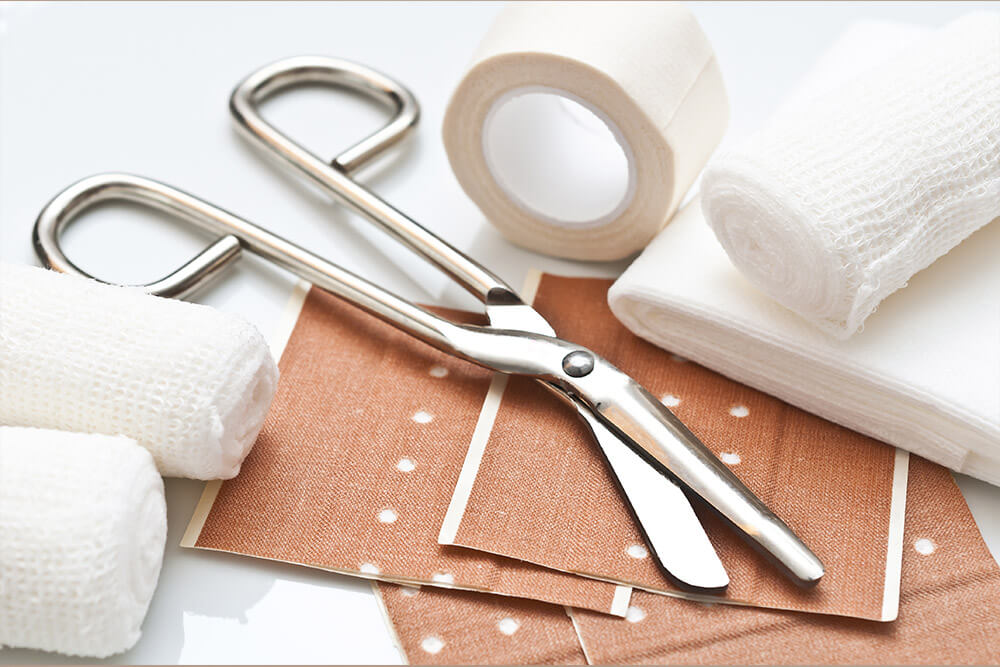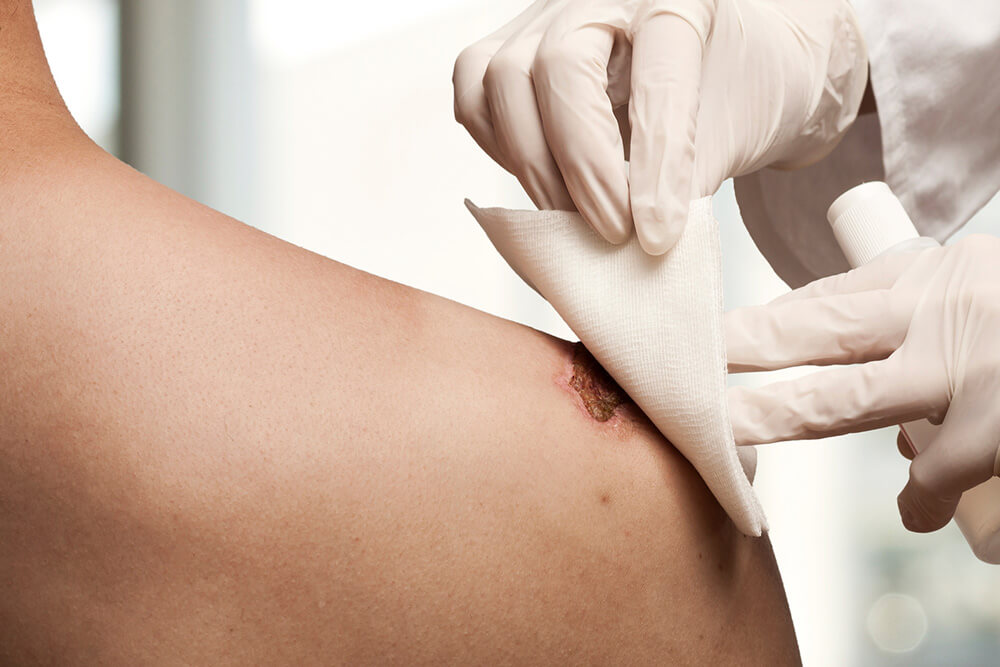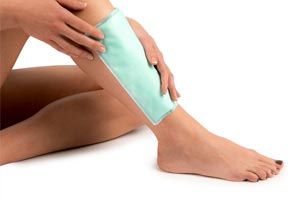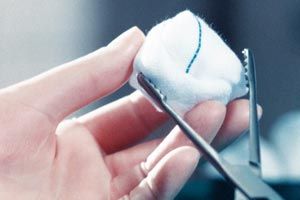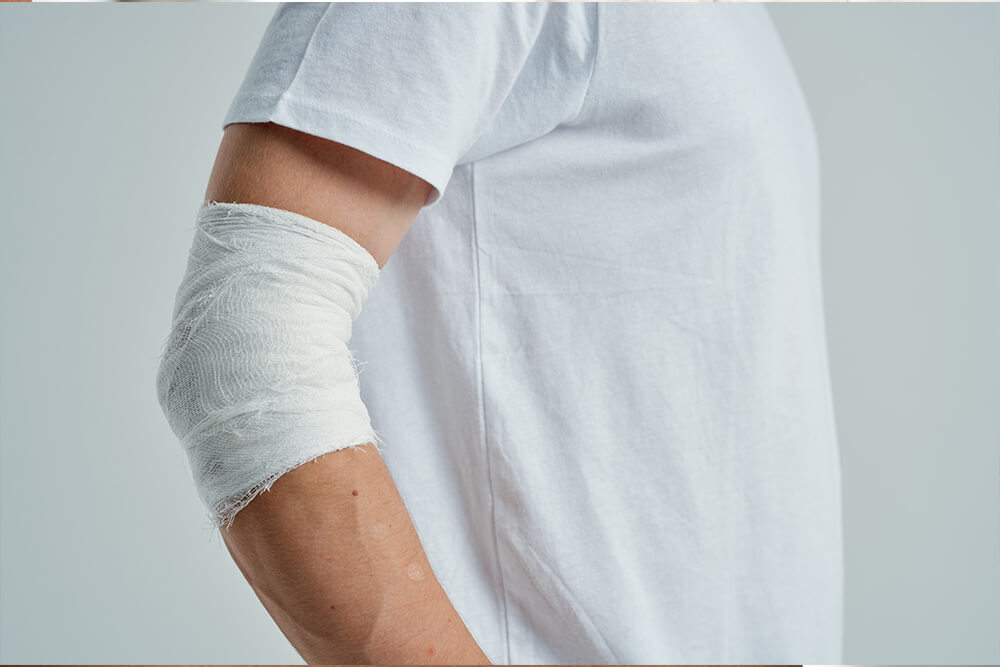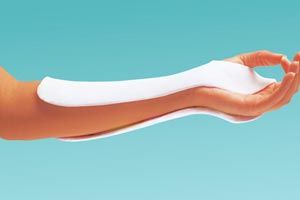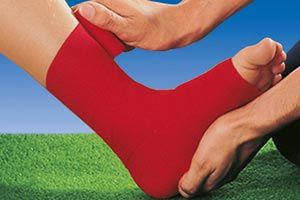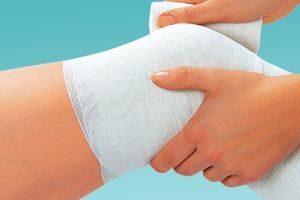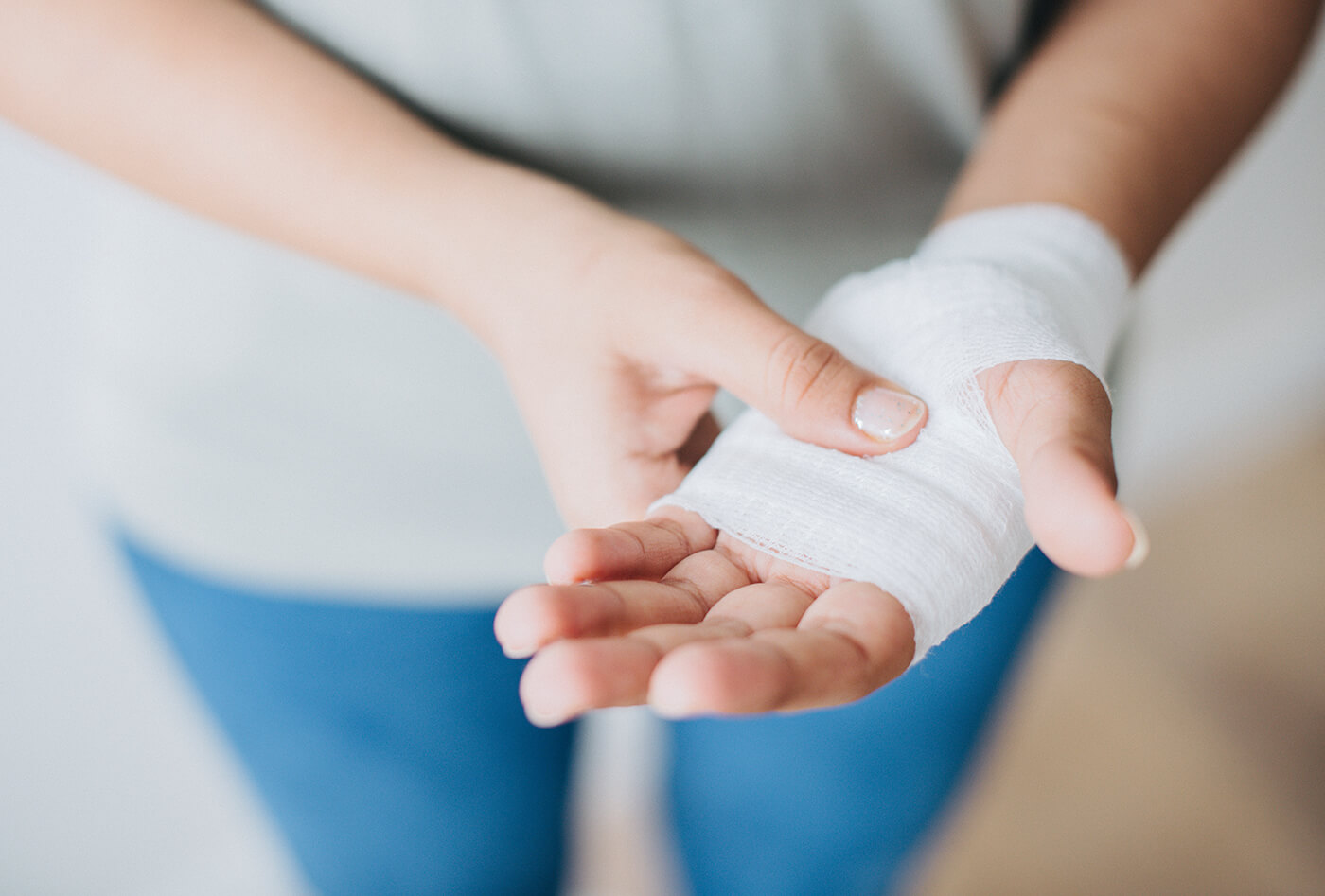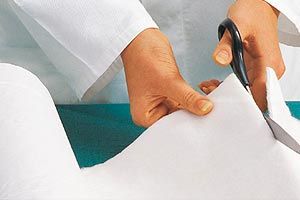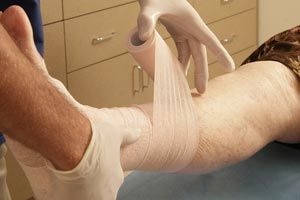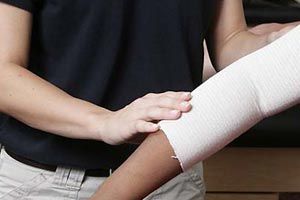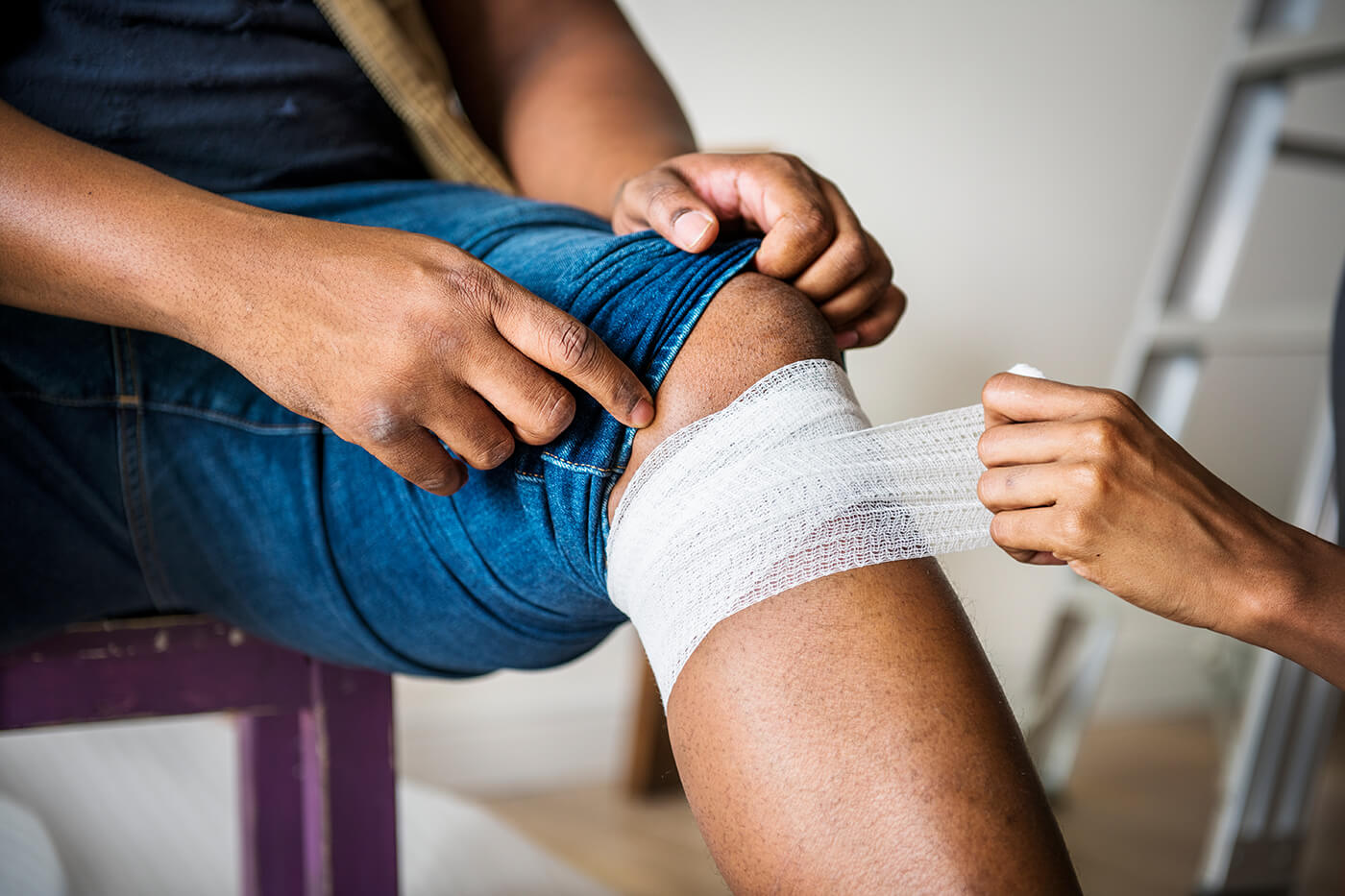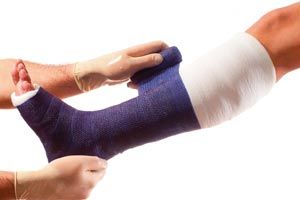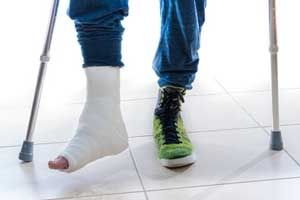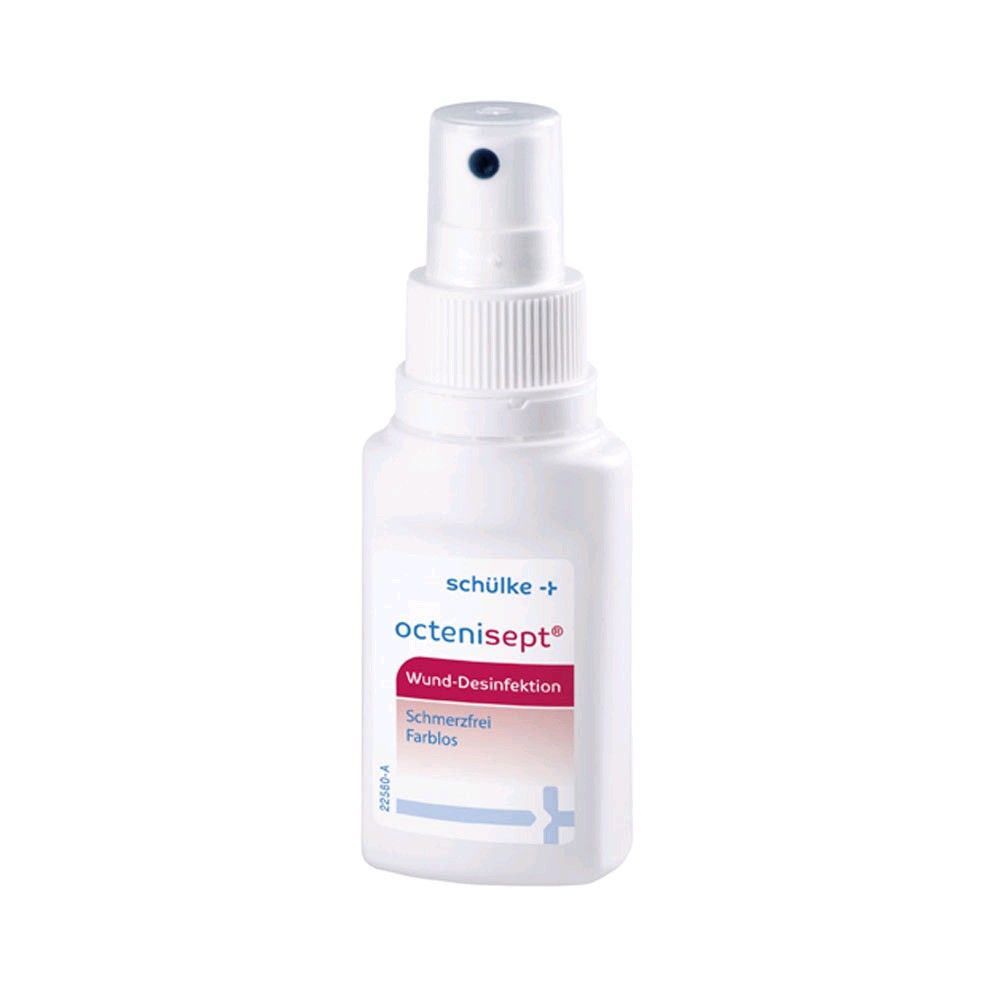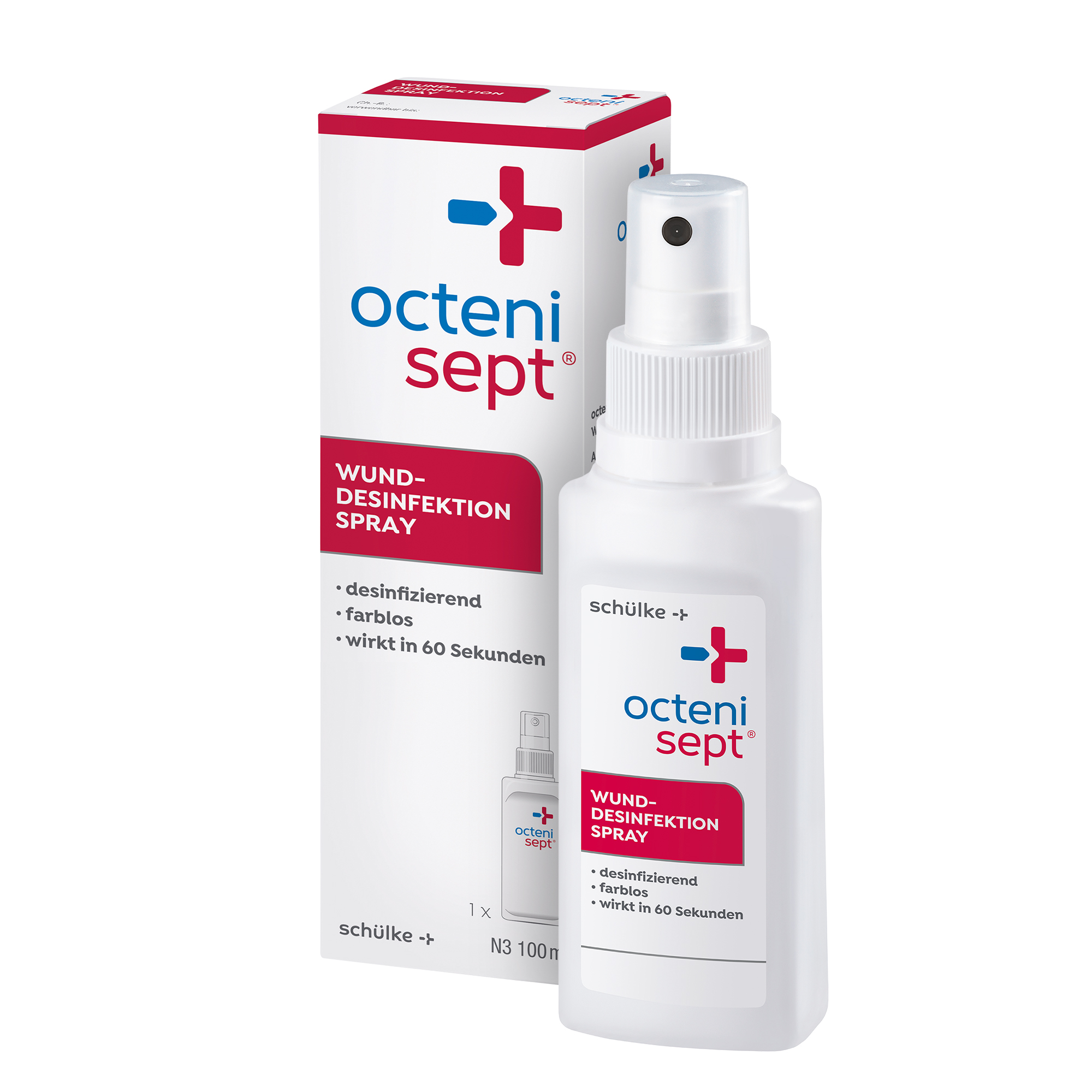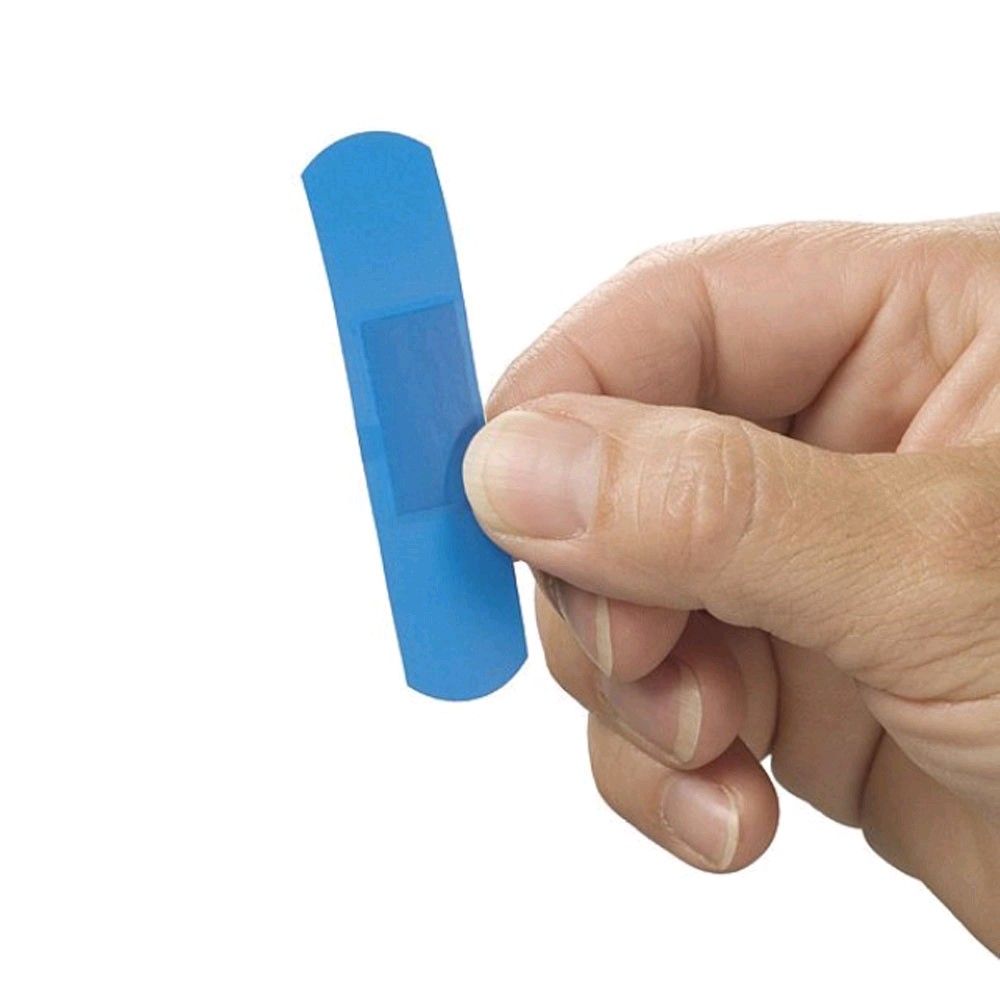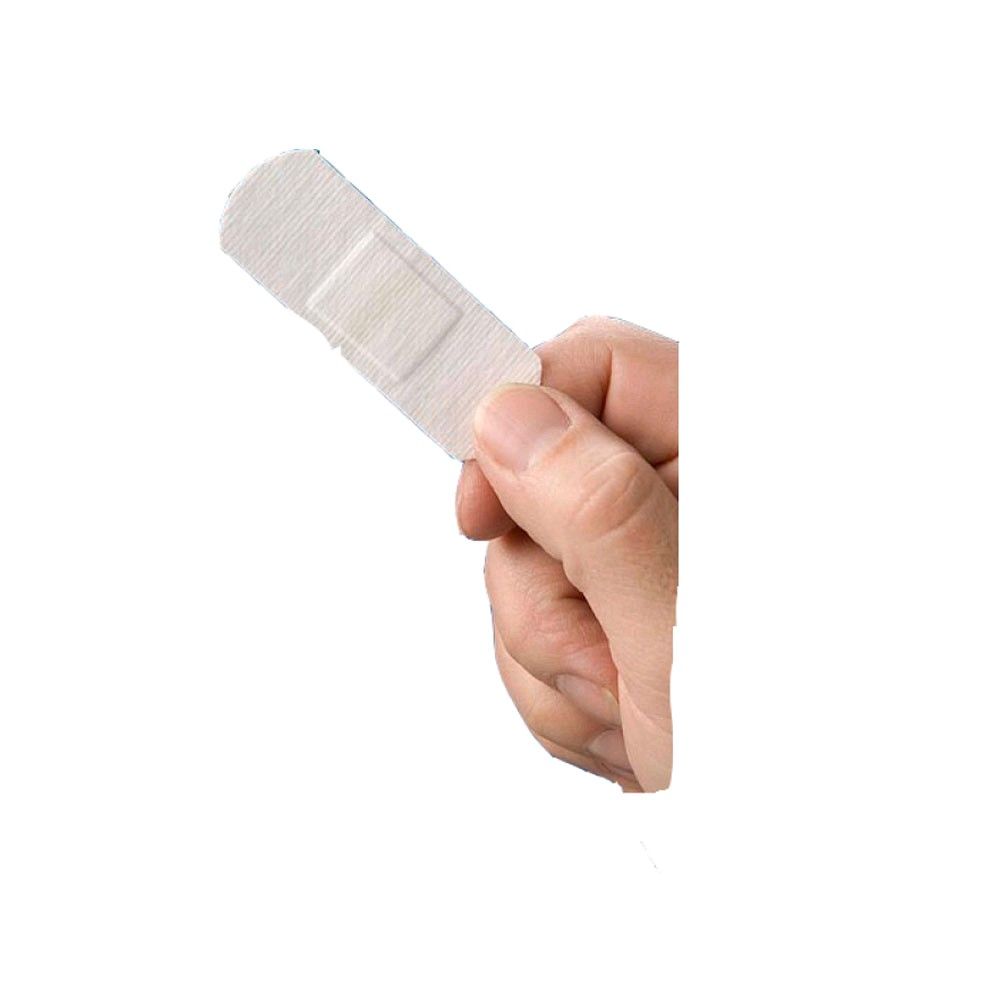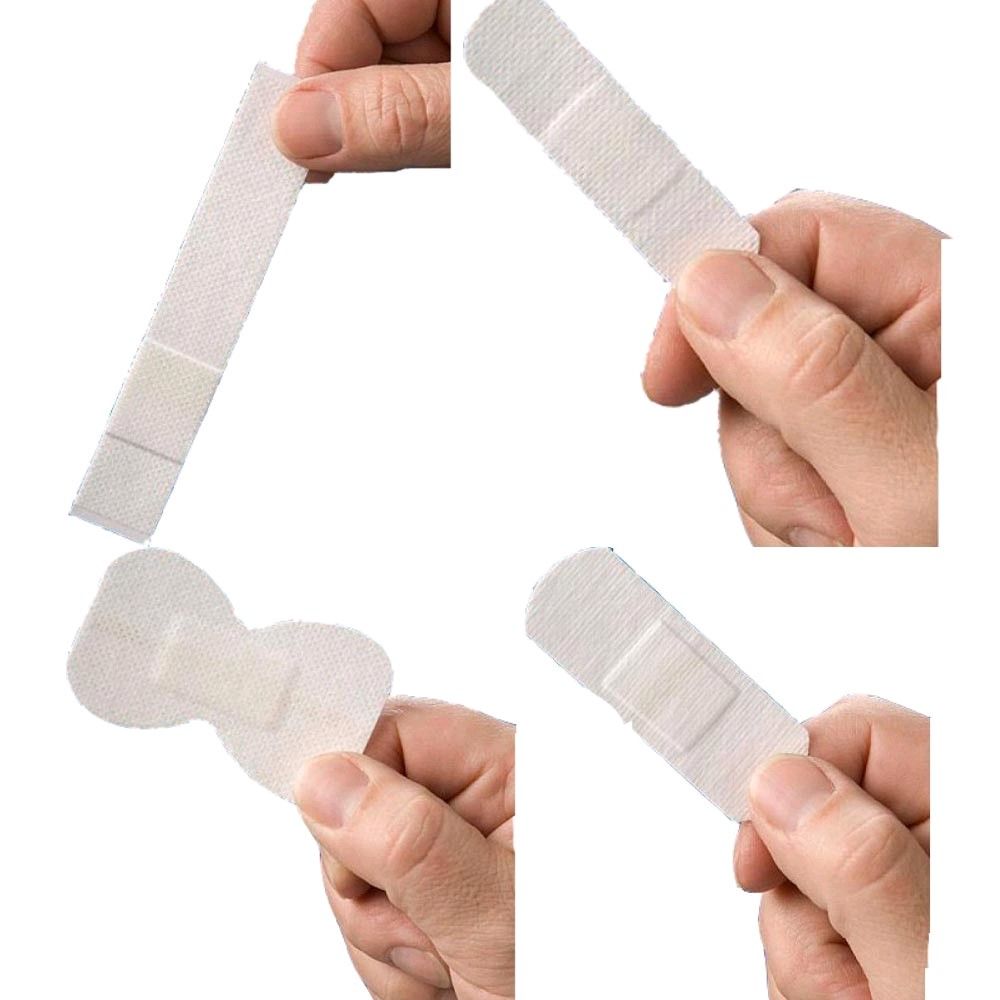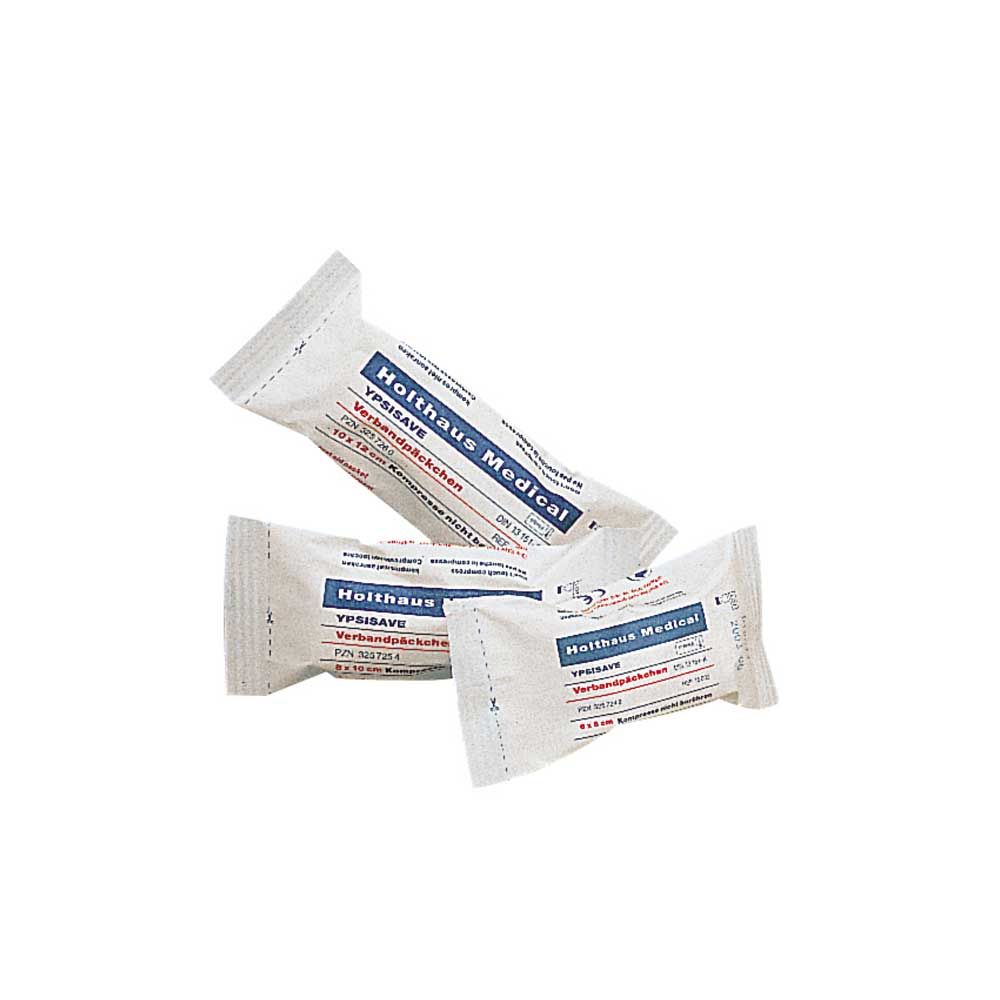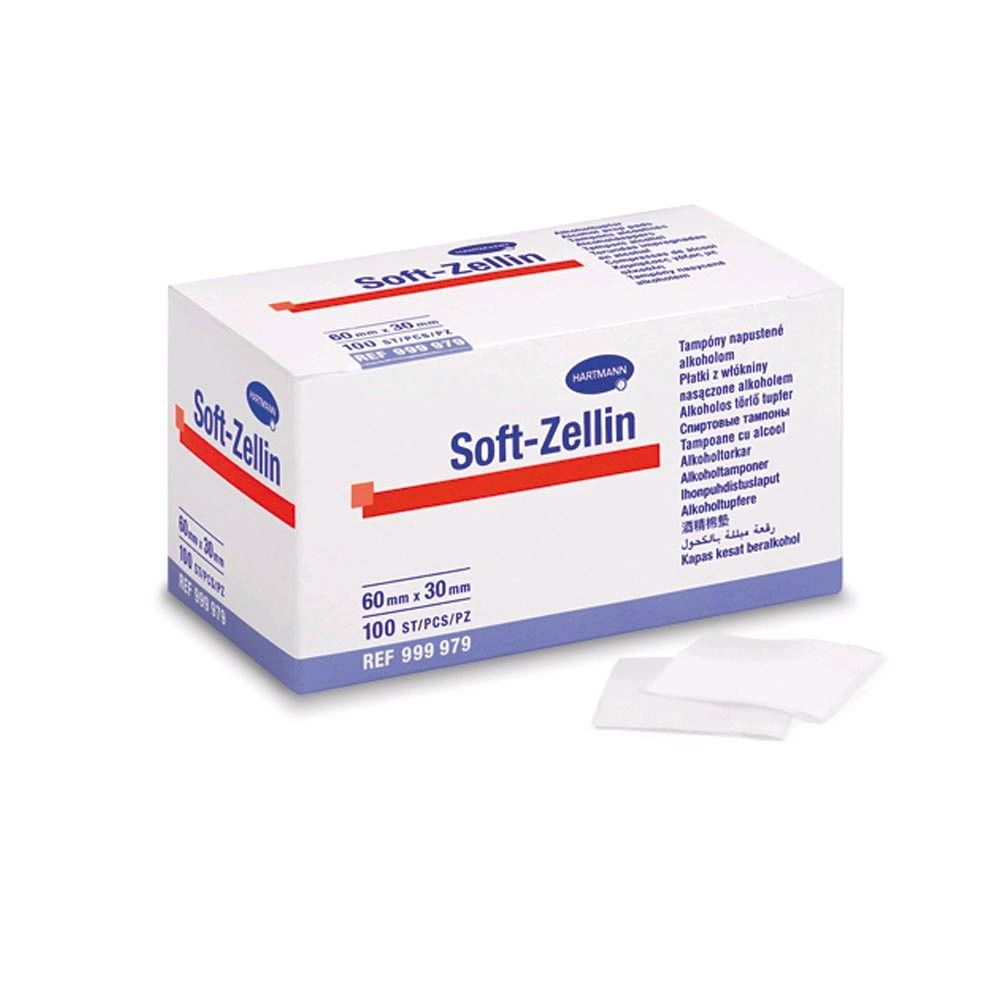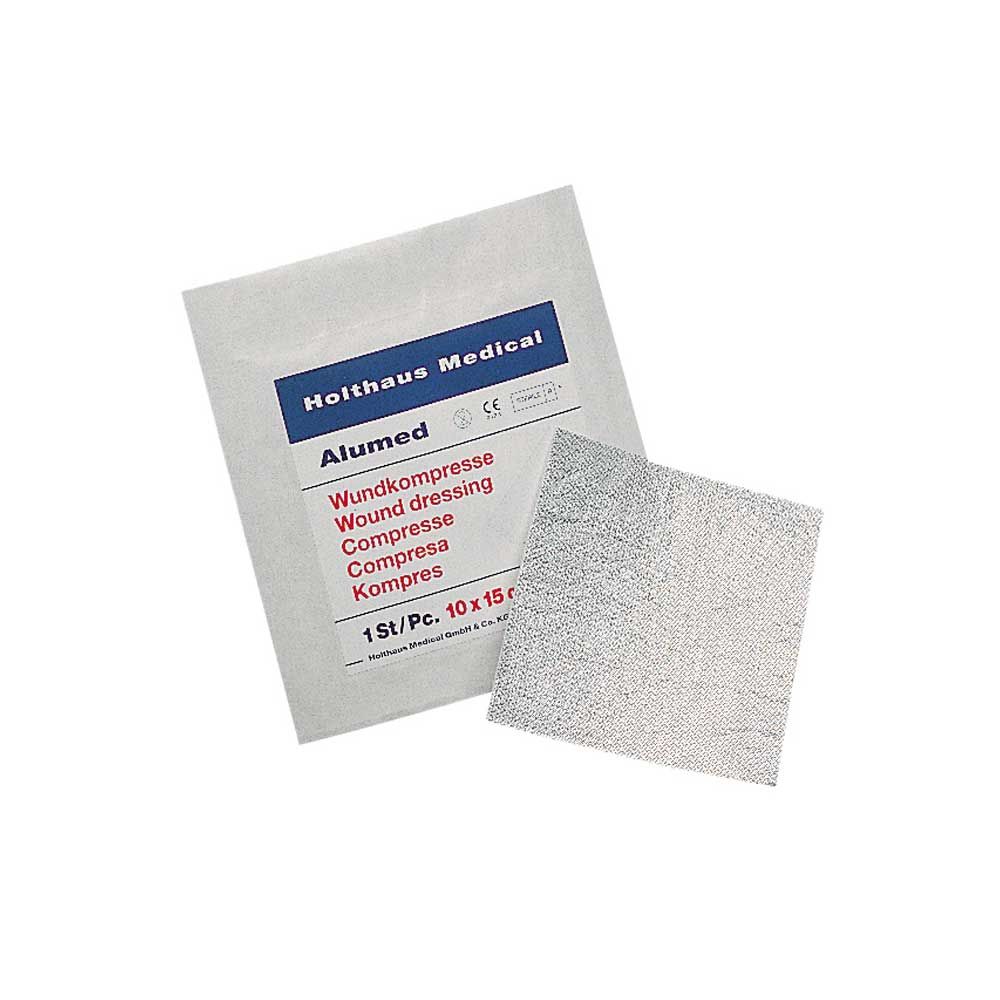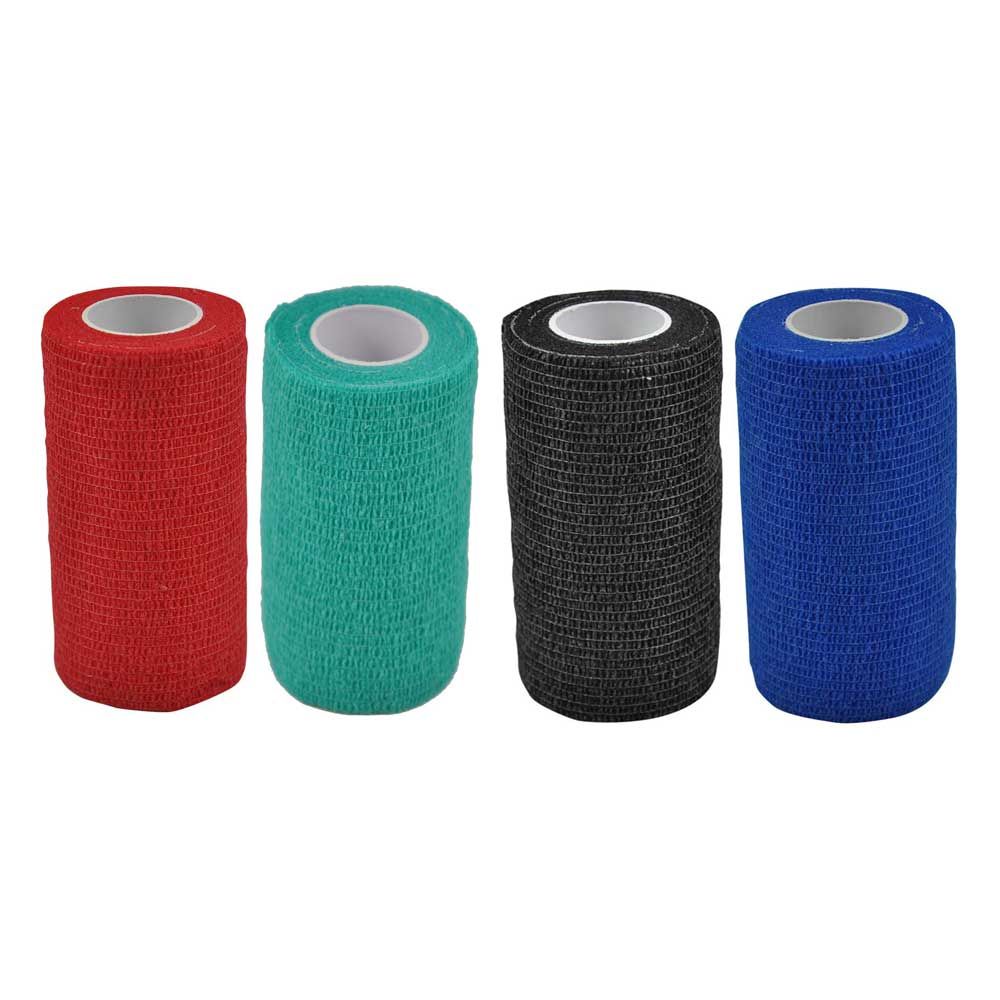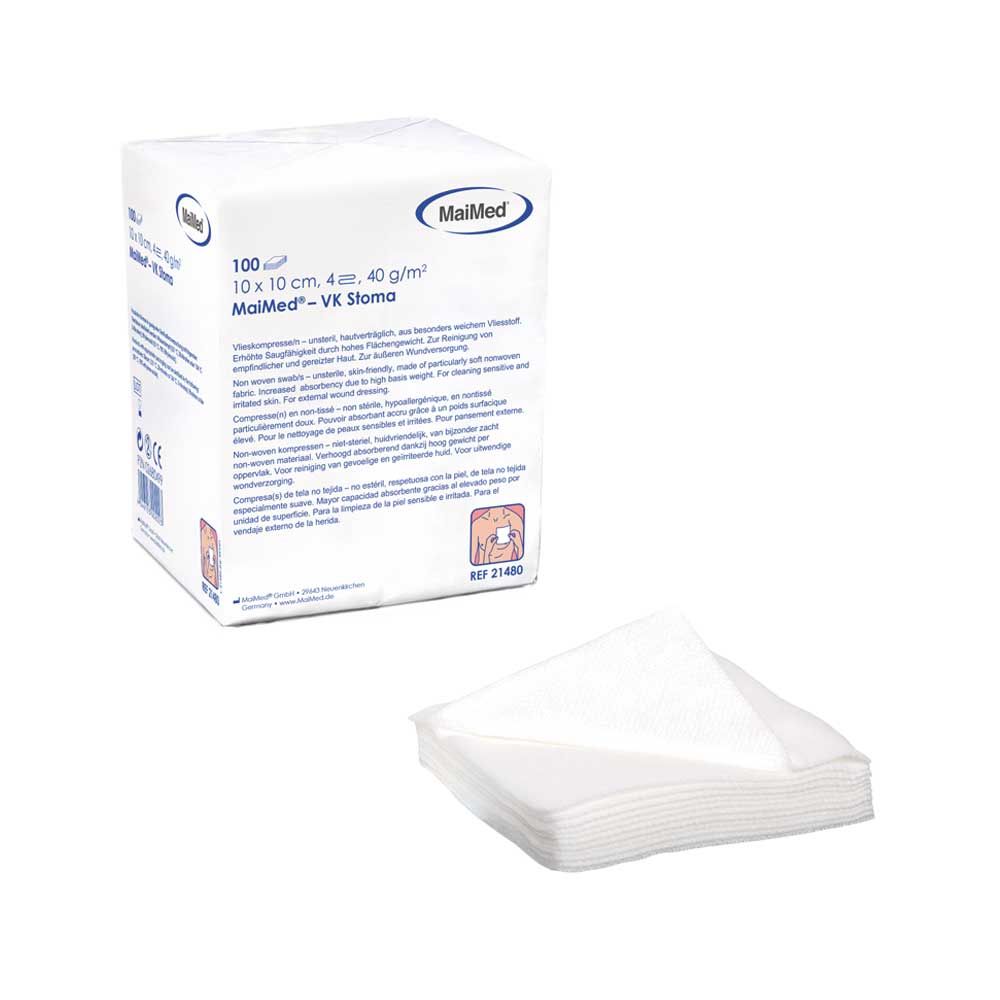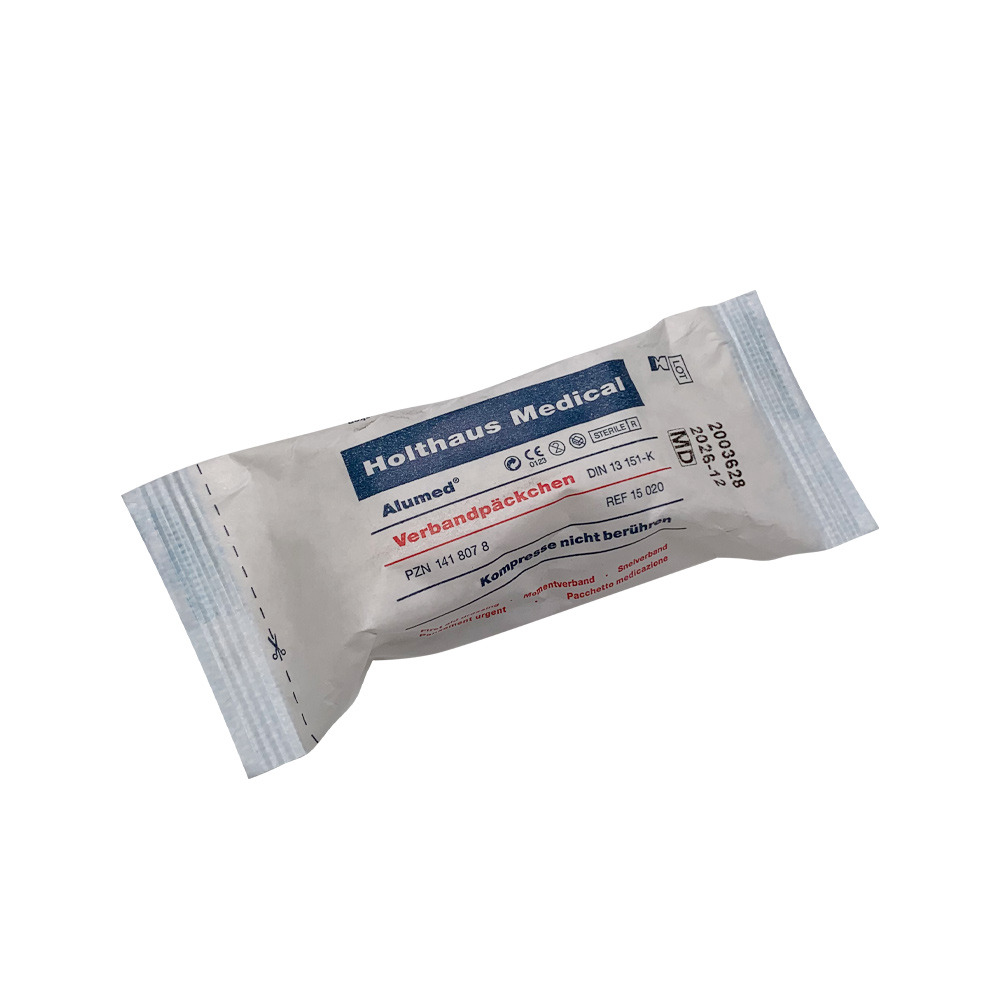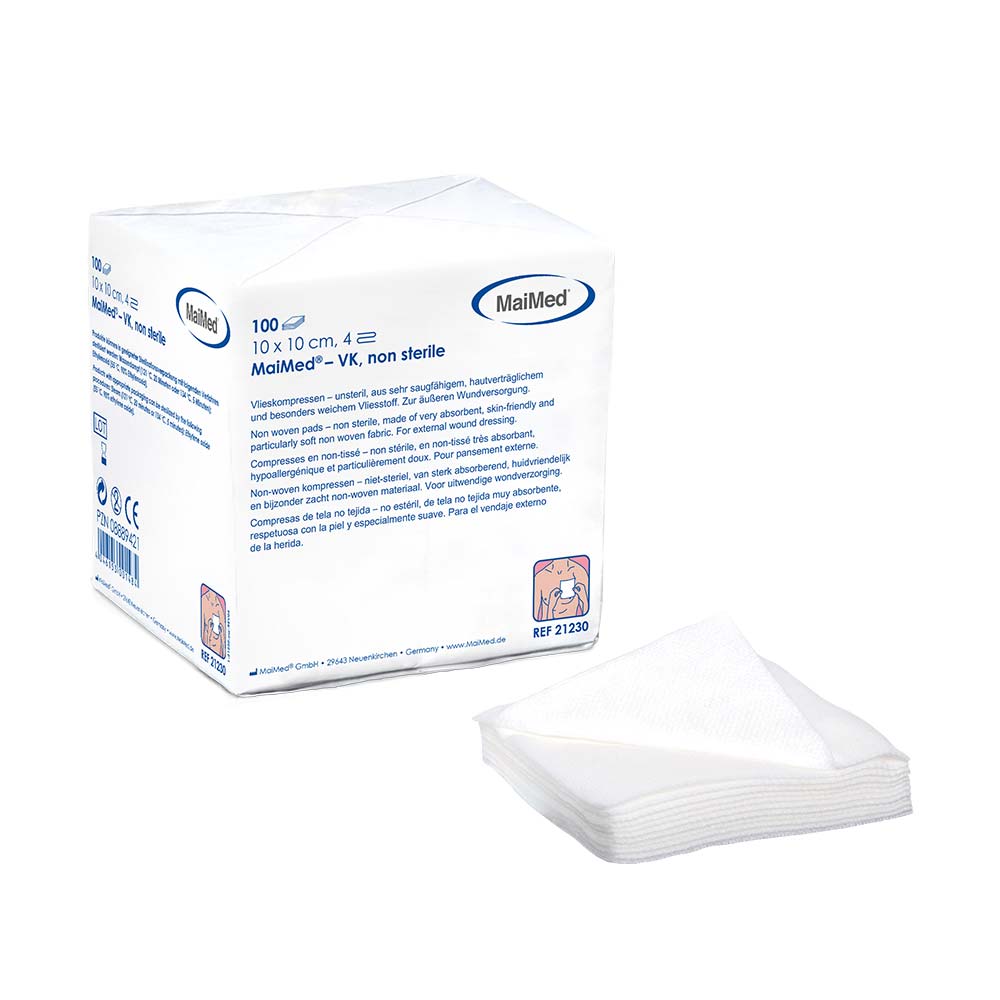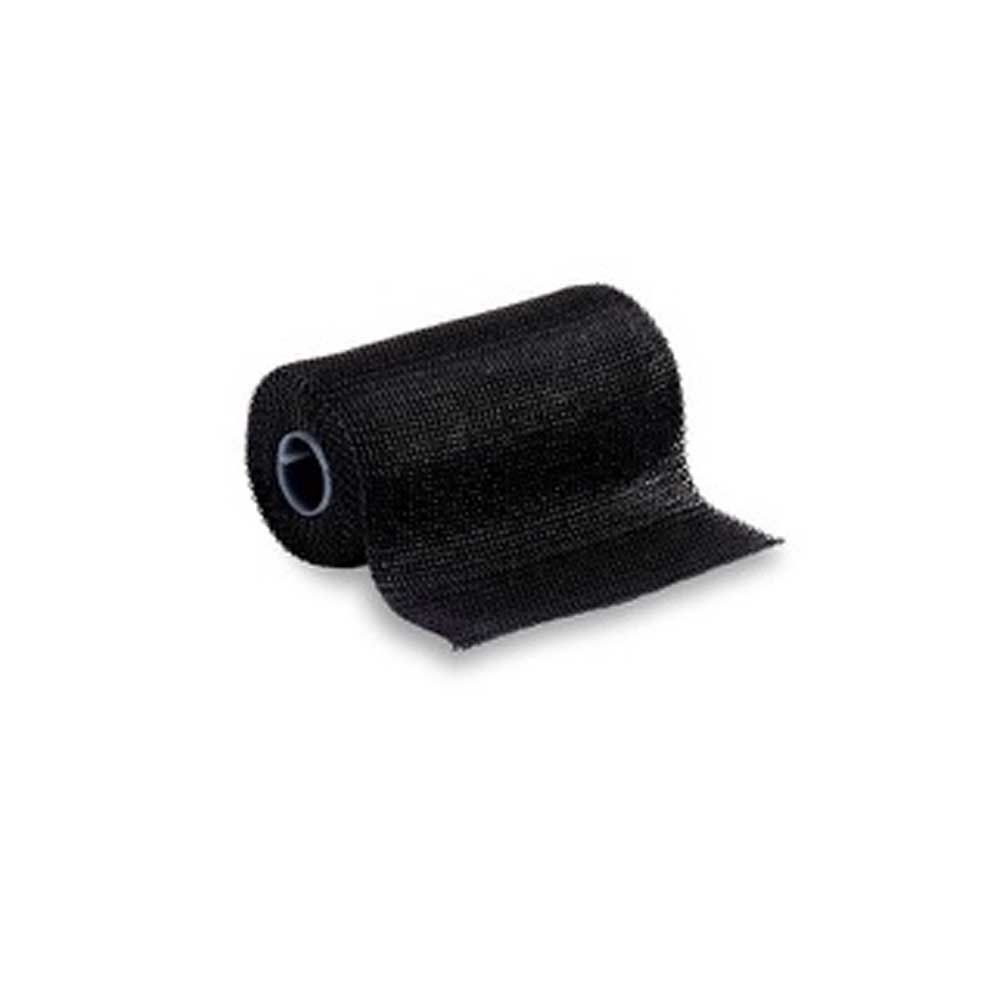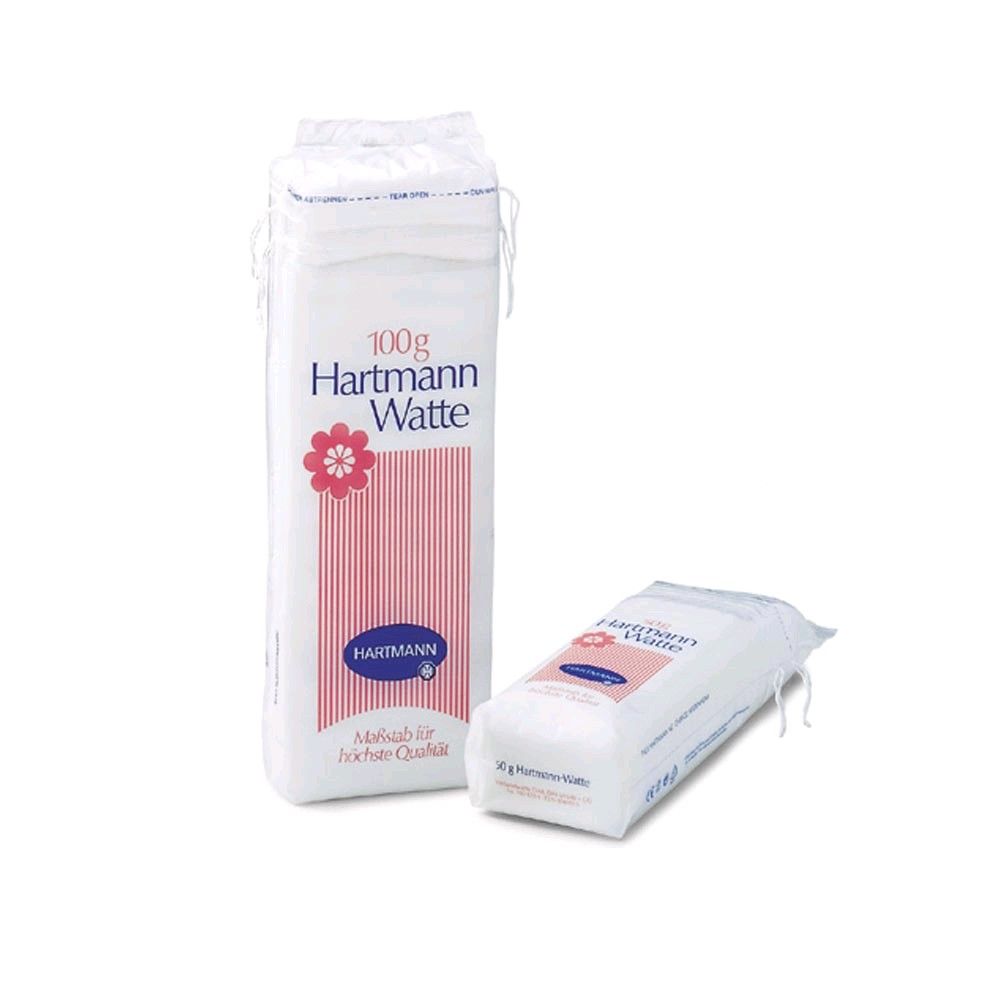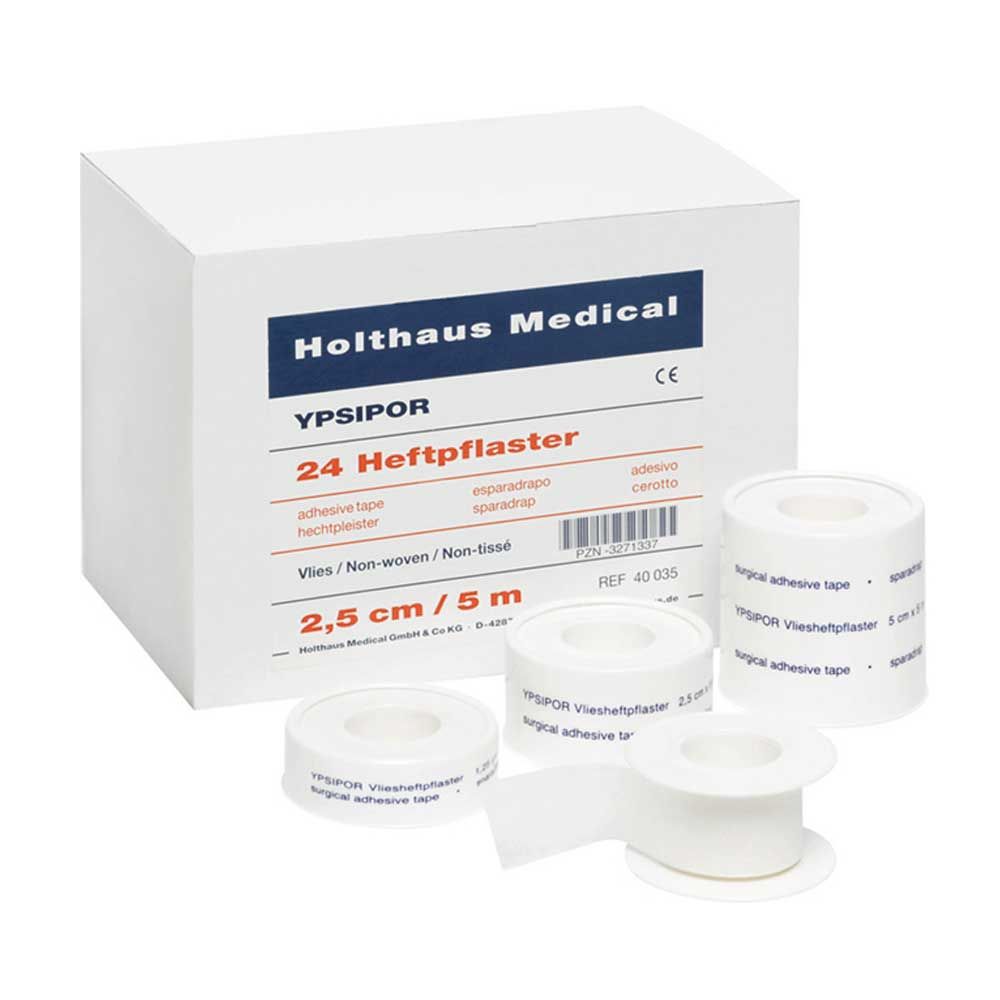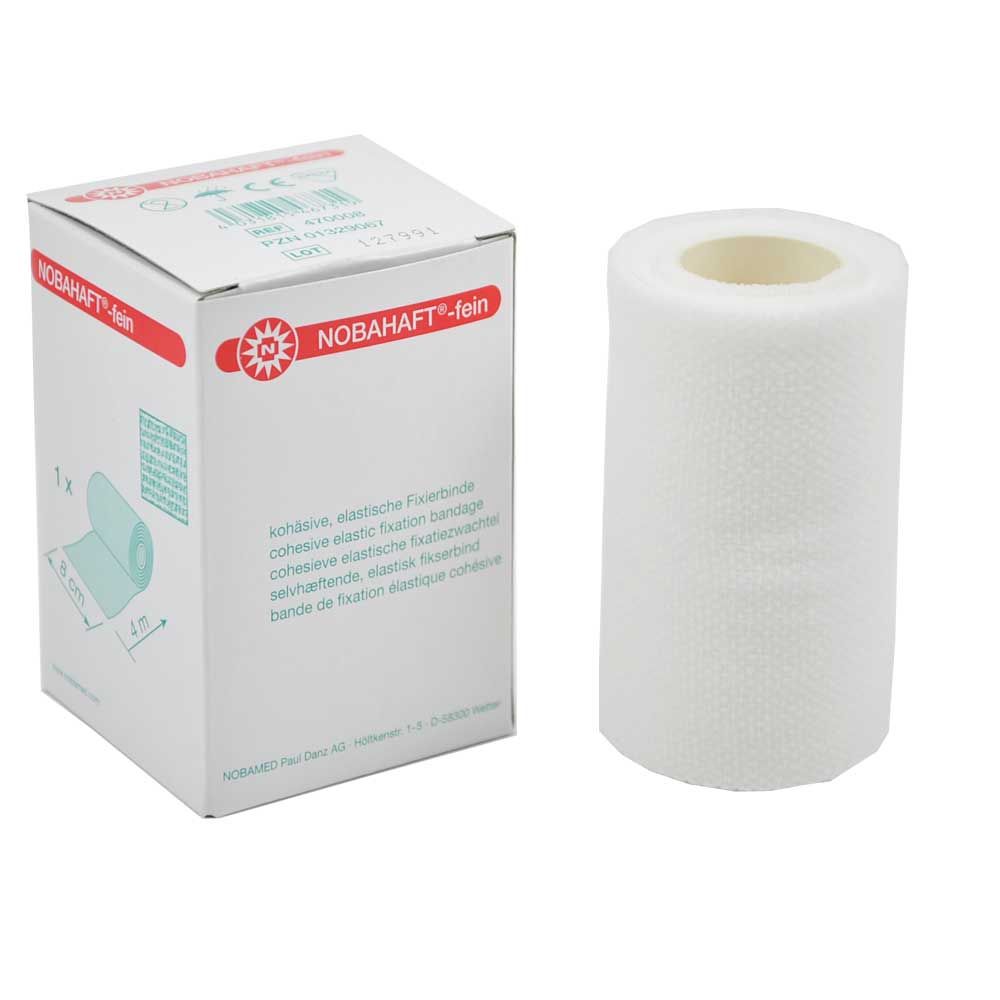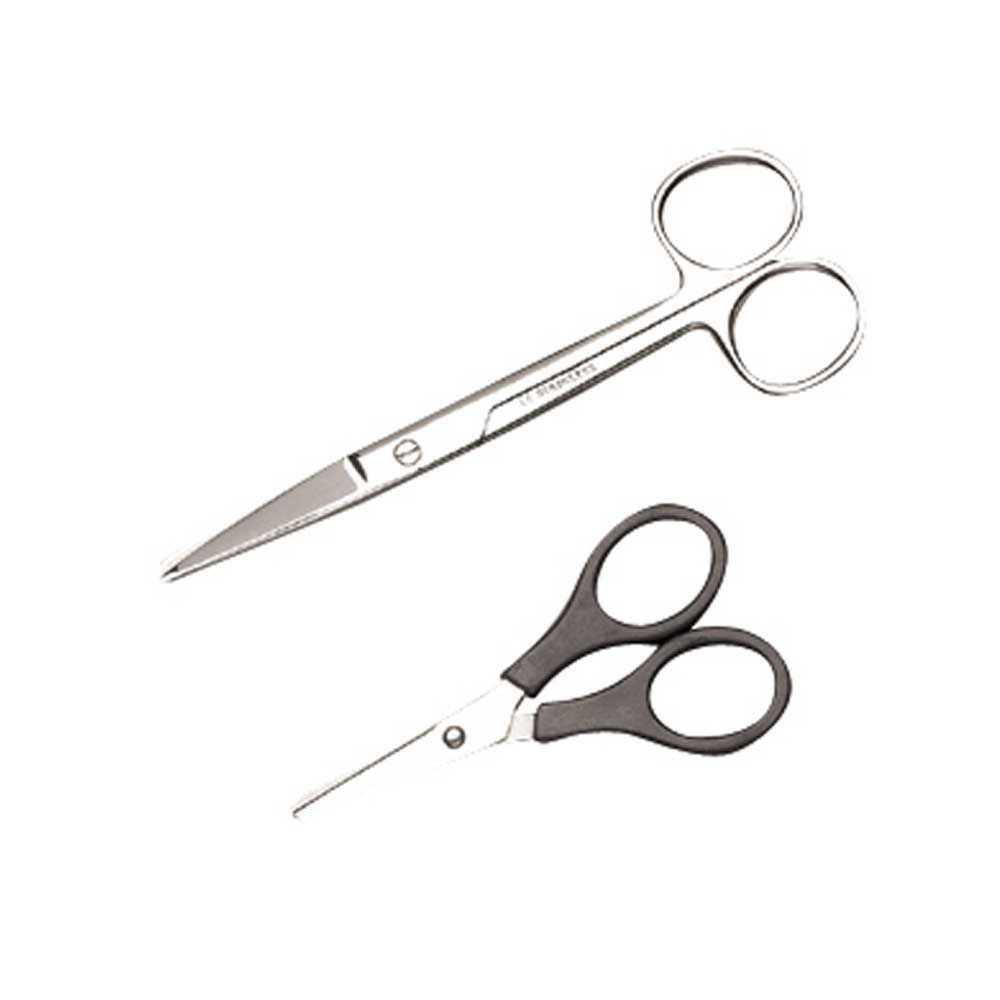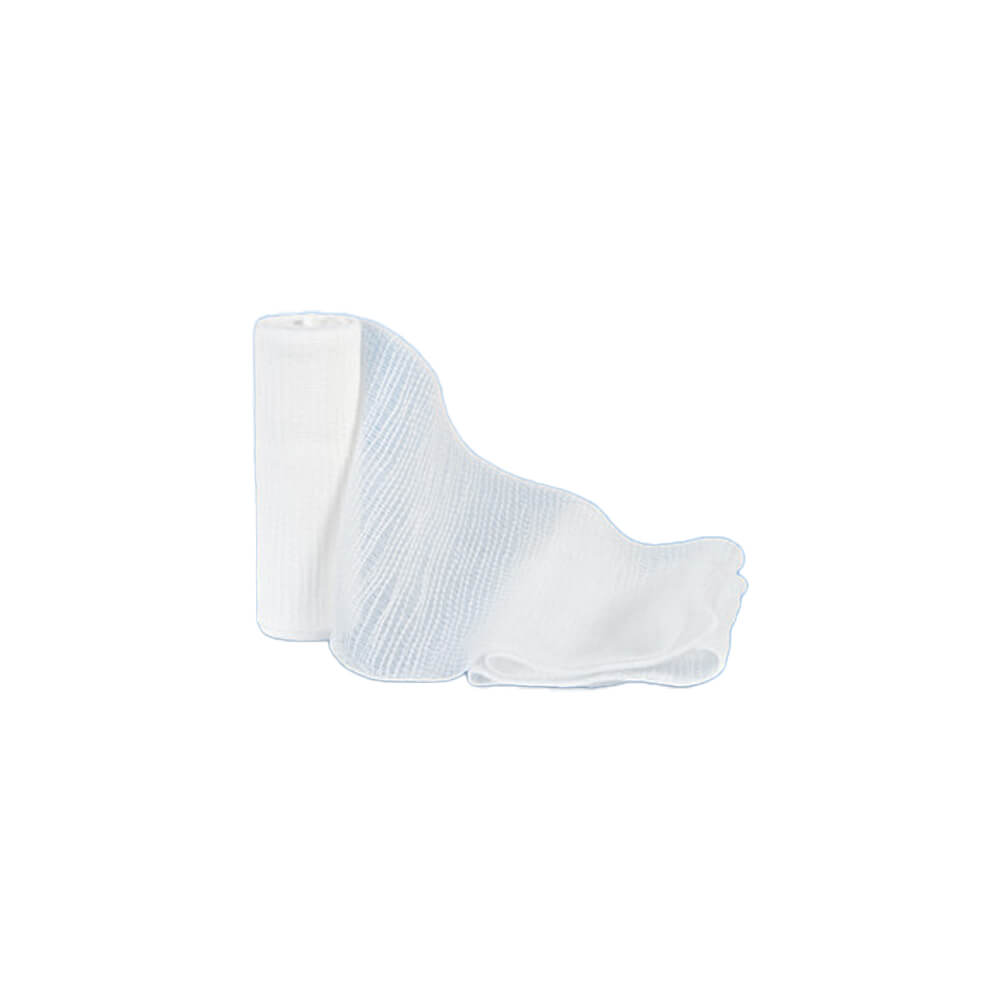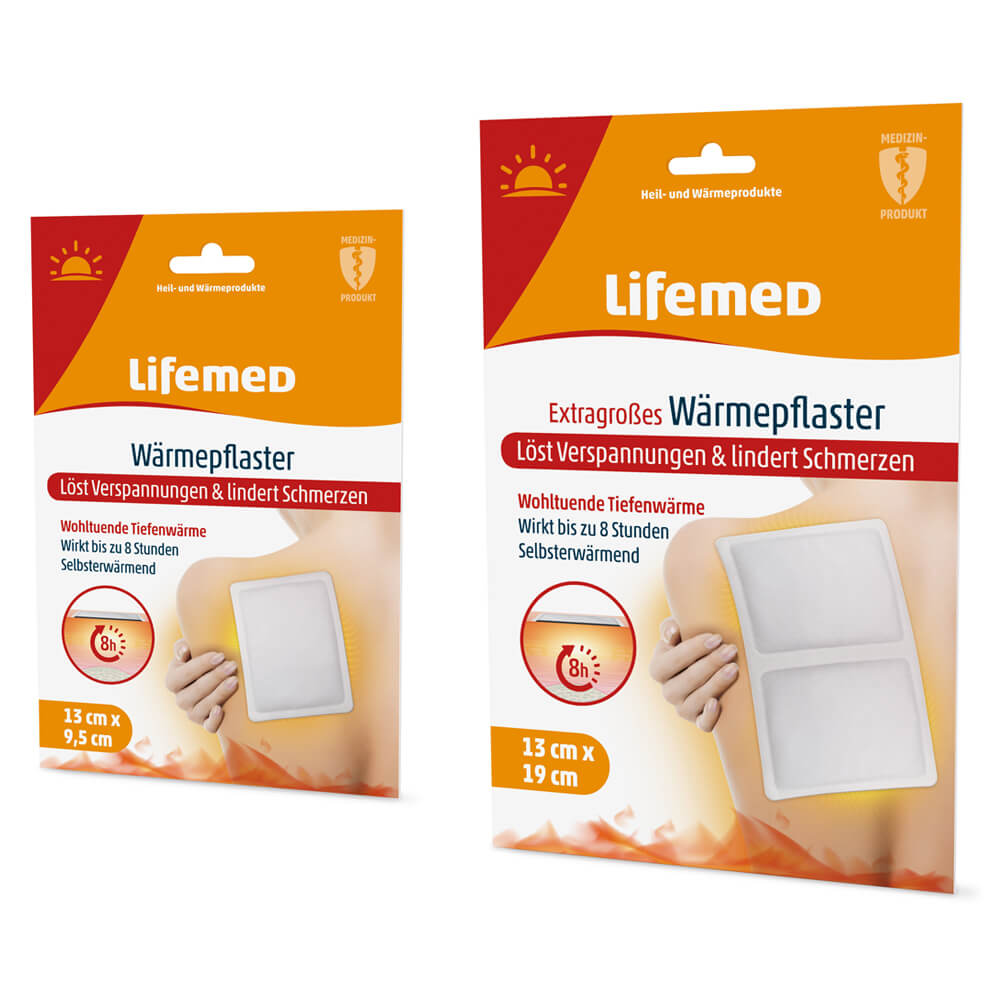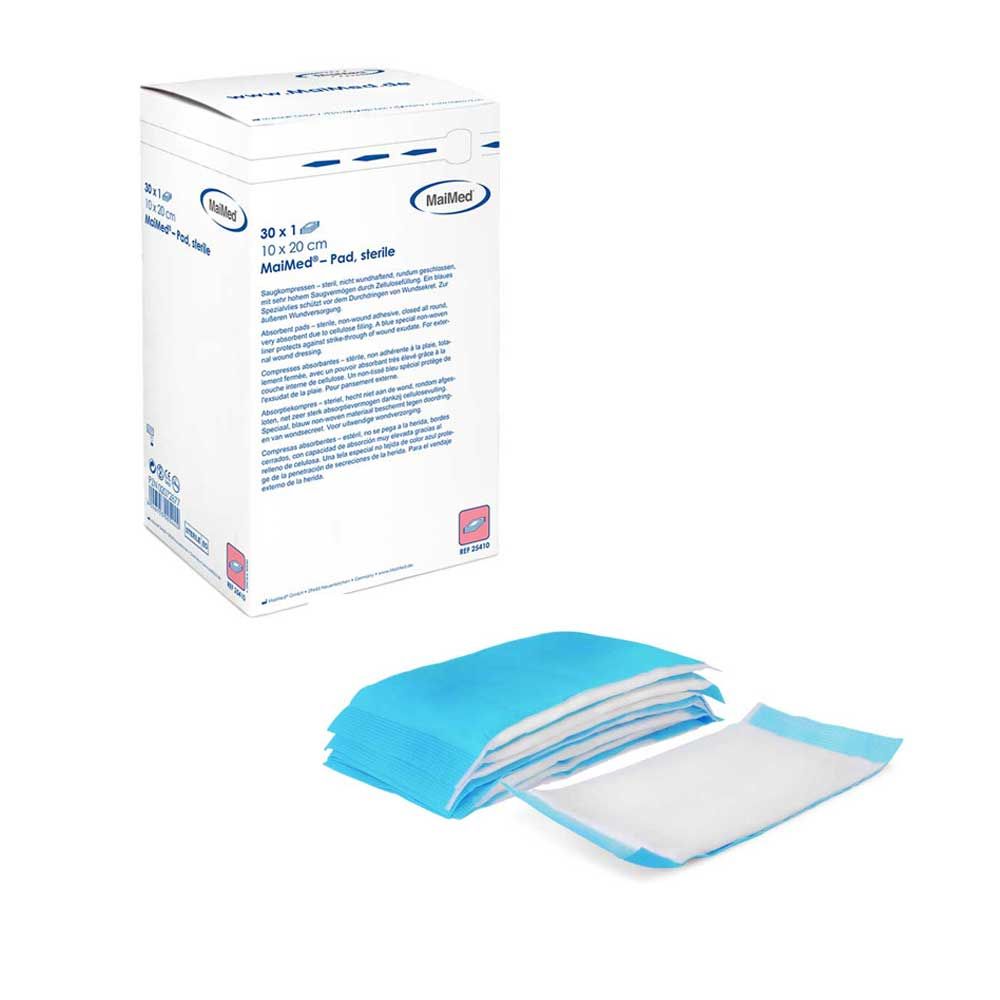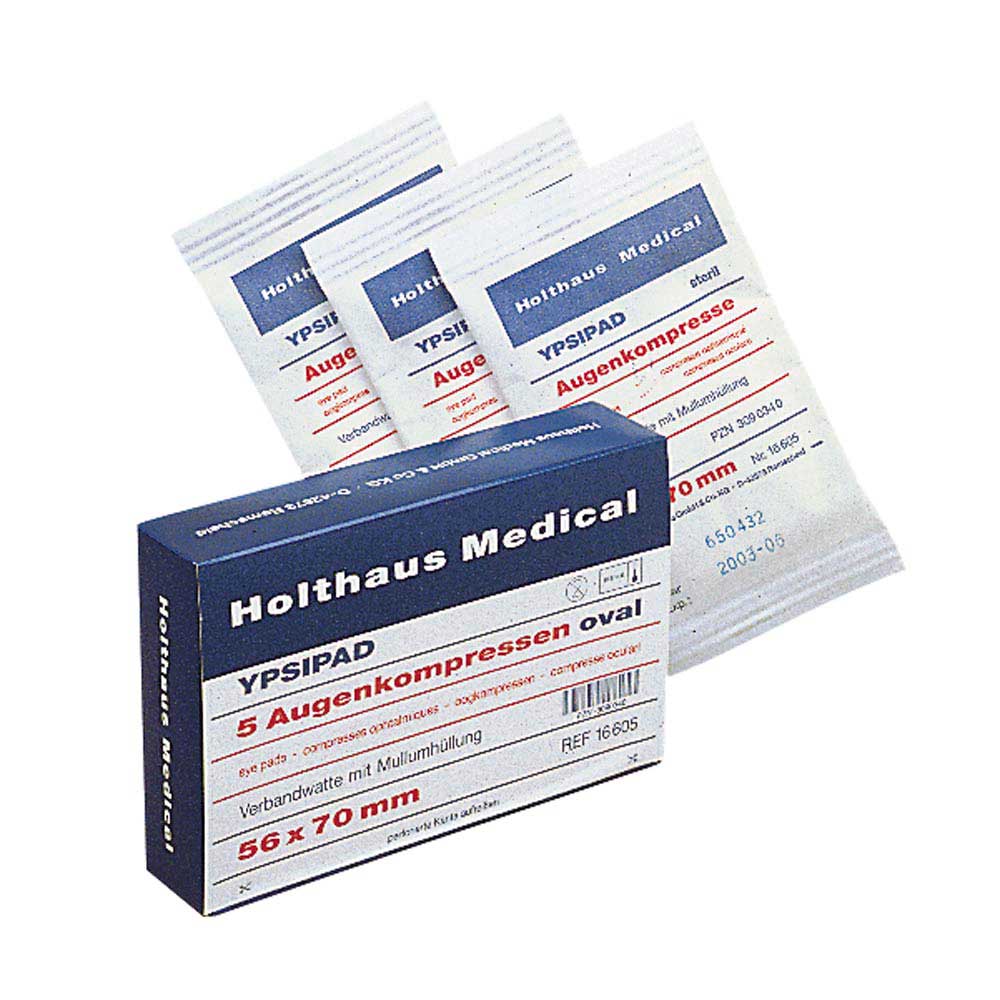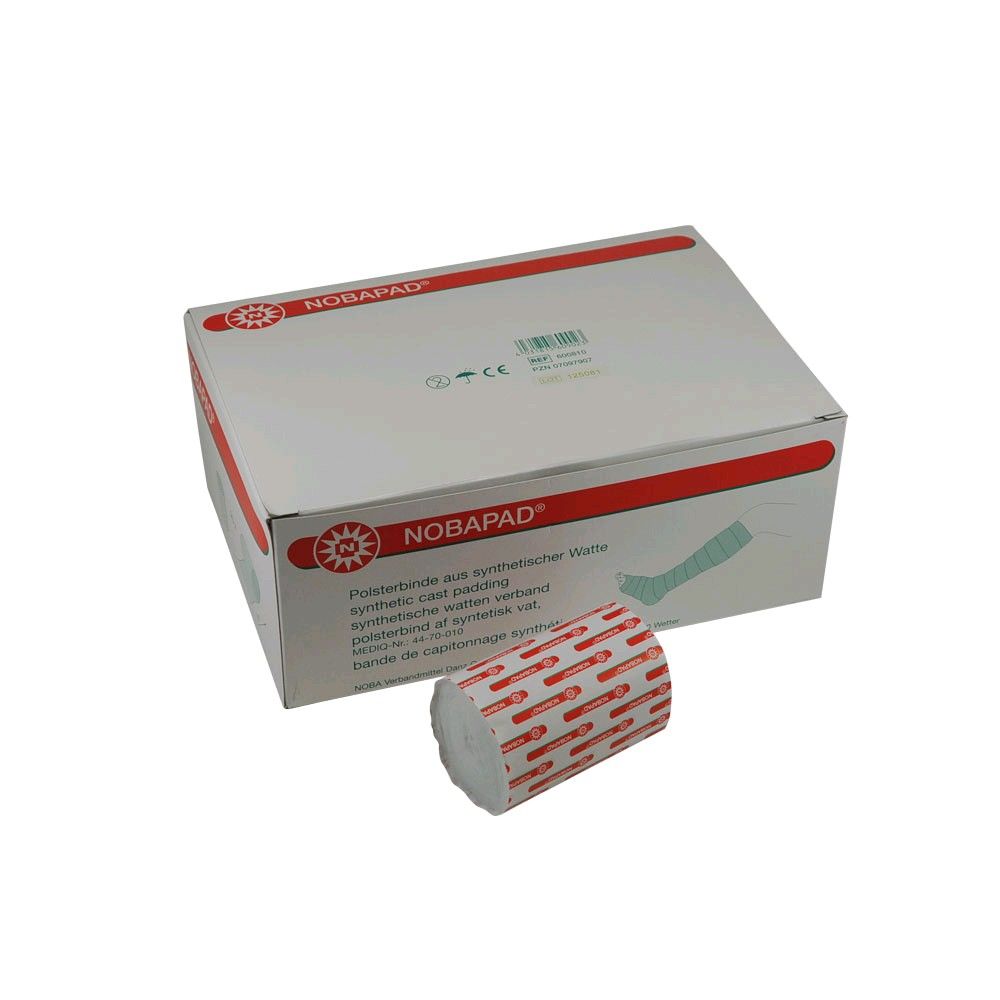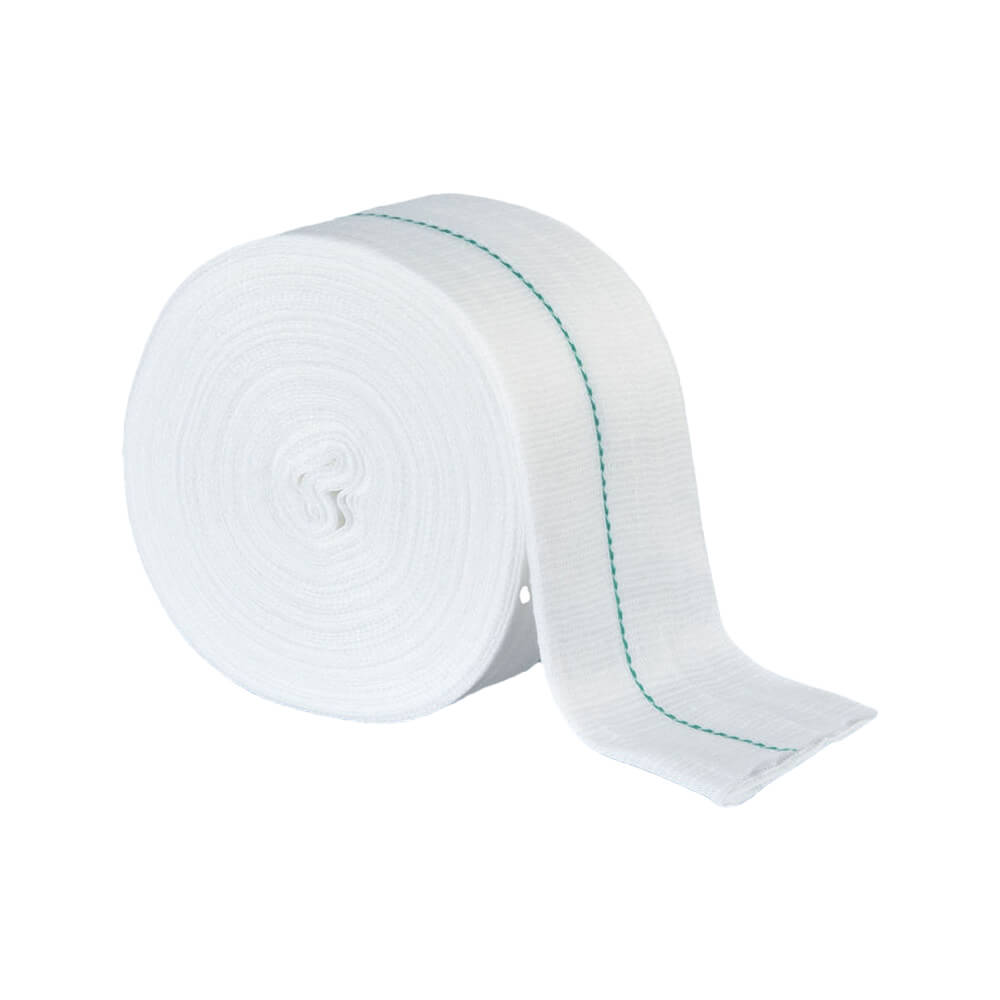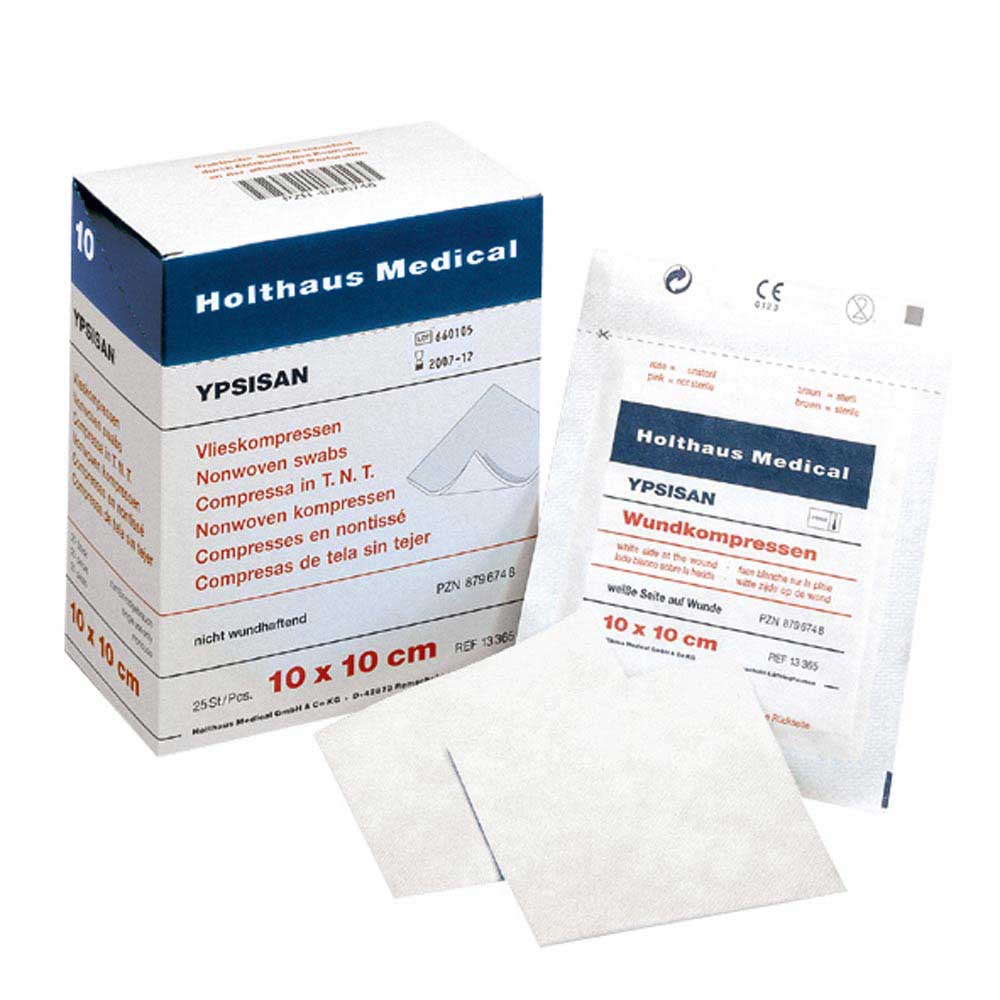Buy Bandaging Materials for Sterile Wound Care
Whether at home or on the go – skin injuries often happen suddenly and can be deeper than expected. That’s why it’s essential to be equipped with the right wound care products. Bandages with sterile wound dressings stop bleeding and prevent dirt and germs from entering the open wound. Such sterile bandaging materials are available at Medicalcorner24 in various sizes, colors, and packaging units. You will also find hypoallergenic or water-resistant bandages and plasters that are easy to use and provide a strong hold. Our wound care bandages, elastic bandage wraps, as well as cast and plaster bandages for immobilizing limbs, stand out for their highest medical quality.
Take advantage of these benefits:
- comfortable & pain-free plasters & bandages
- strong adhesive power for greater durability
- single-use for maximum hygiene
- order hygienic bandages quickly & affordably
Order medical bandages supplies now at Medicalcorner24! Our online shop offers various types of medical bandages for general hospital or clinic needs, businesses, schools, kindergartens, and private use. Read more now…
Content: 0.05 L (£154.74* / 1 L)
Available
Content: 0.1 L (£101.50* / 1 L)
Available
Content: 4.5 m (£0.36* / 1 m)
Available
Content: 6 m (£0.09* / 1 m)
Available
Content: 0.4 kg (£15.89* / 1 kg)
Content: 5 m (£0.18* / 1 m)
Available
Content: 4 m (£0.26* / 1 m)
Available
Content: 4 m (£0.03* / 1 m)
Available
Available
Content: 15 m (£0.10* / 1 m)
Buy Hygienic Bandages to Prevent Contamination
Just as quickly as injuries occur, wounds can become contaminated with bacteria. High-quality wound care bandages are essential to prevent infections, but they are also useful in many other situations. These sterile bandages promote blood clotting and, if necessary, apply pressure to the wound to help stop bleeding more quickly. Sterile wound dressings do not stick to bleeding or oozing wounds and protect them from germs. Once the wound has healed, these hygienic products can be easily and painlessly removed.
Furthermore, support bandages can stabilize or even immobilize larger body areas, actively promoting the healing process with hygiene products for wound care. Certain materials are also highly absorbent, helping to soak up wound fluids such as exudate and wound secretions using absorbent sterile wound dressings. Specialized pressure ulcer bandages help prevent pressure sores or gently cover existing ones.
Of course, an effective application in any of these situations requires proper cleaning and disinfection of the affected area. Medicalcorner24 offers the right type of bandaging material for every need, available for online ordering, ensuring careful wound treatment. By the way, we also offer the option to order all types of medical bandages with a prescription.
Order Professional Bandaging Material at Affordable Prices – Our Range
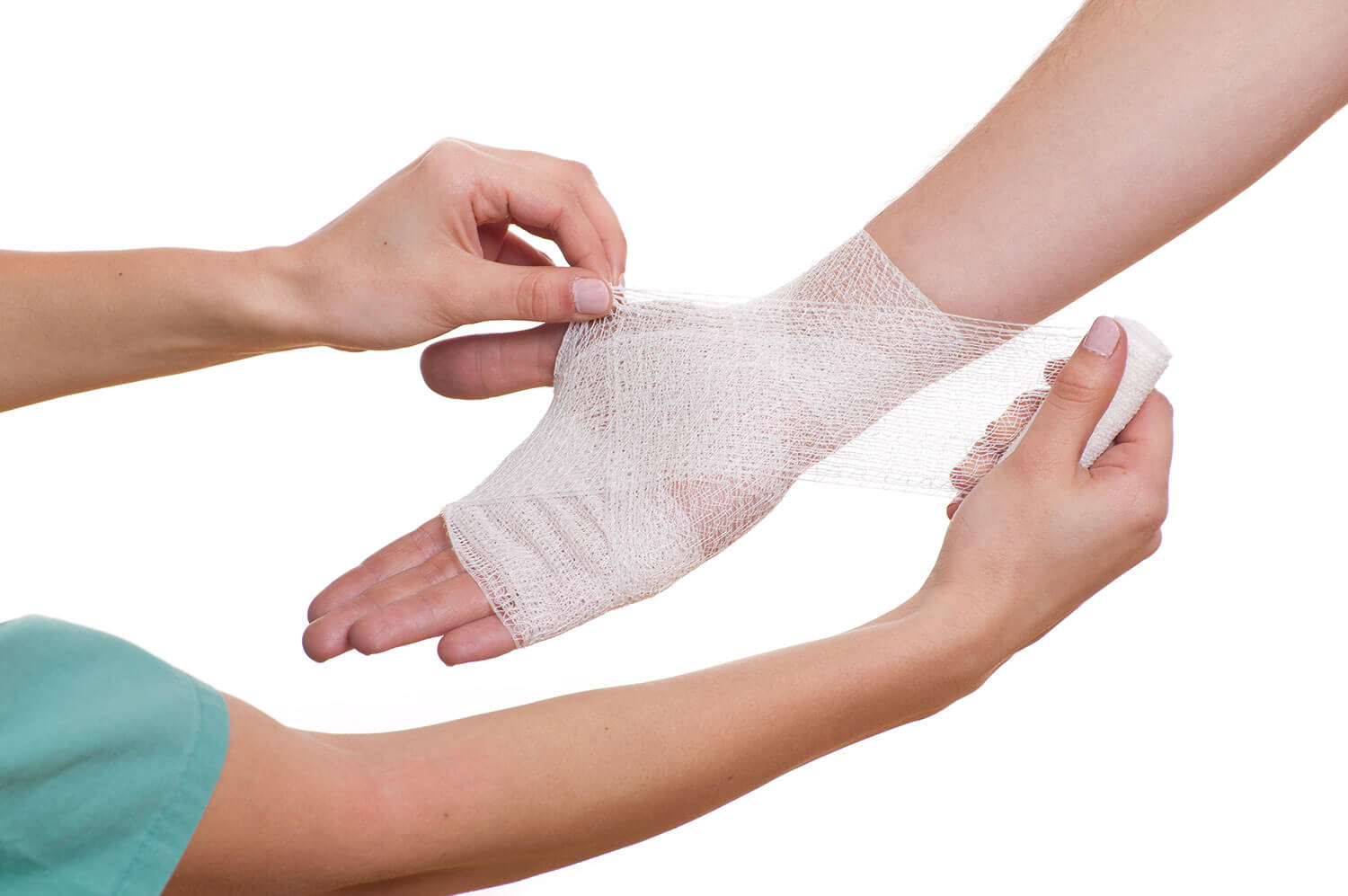
Bandaging materials are an essential component of medical care and include various items for first aid, wound care, nursing, and scar prevention. In daily clinical, nursing, or practice routines, a large number of universal, fixation, and gauze bandages, cast and tubular bandages, plaster bandages, compression bandages, cotton wool, and swabs are regularly used. Likewise, bandages as medical consumables must also be readily available outside of medical facilities, for use while traveling or at home. Here, plasters and finger bandages are particularly useful.
In our online shop, you can order the appropriate medical bandaging supplies for both home and practice in convenient quantities to meet your needs for bandages as well as bandaging accessories such as bandage scissors, clips, or safety pins.
We offer professional bandaging materials from renowned manufacturers such as Hartmann, Holthaus, Noba, Lifemed®, and MEDIVID. These types of medical bandaging materials are available in various colors, such as classic white, like surgical bandages, as well as green, blue, or skin tones. We leave it to you to cater to individual needs and offer our bandages in numerous lengths and widths.
We carry high-quality sterile bandages, antiseptic dressings, antibacterial bandages, compression bandages, plasters, net-like bandaging materials, and other types of single-use bandages. We also have bandaging materials suitable for use on dogs, horses, and other animals in our range. Below you will find an overview of our bandaging materials. Learn more about the products in our online shop and when they are typically used.
Elastic bandages are known for their high elasticity. These medical consumables are versatile and are used for making plaster casts, compression bandages, or wound dressings, among other things. Elastic compression bandages, for example, have the advantage of promoting venous blood flow and applying gentle pressure without constricting the bandaged body part.
Universal bandages are also highly elastic. Thanks to their cohesive adhesive properties, these bandages stay securely in place even during movement. Since they do not slip easily, universal bandages are often used for compressive pressure bandages or wound care bandages on the limbs. Elastic bandages are also frequently ordered for support bandages or for applying fixation bandages. They are among the most commonly used bandaging materials in hospitals and medical practices.
As the name suggests, fixation bandages are used for secure, slip-resistant fixation of dressings. The soft gauze bandages conform to the shape of the body and are ideal for applying snug-fitting dressings that do not interfere with blood circulation. Gauze bandages and compresses are also absorbent and can take up large amounts of fluid, making them essential hygiene products for wound care.
When you order bandaging materials from our online shop, you'll find both elastic and rigid or self-adhesive bandage materials in various sizes and colors. Elastic bandages are primarily used for dressings on hands and feet, while arms, legs, or the torso can generally be wrapped with rigid gauze bandages.
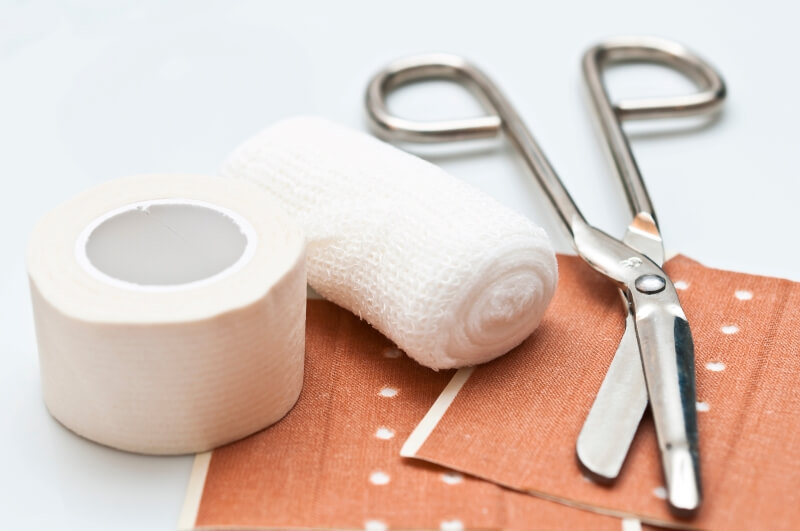
Plaster bandages and cast bandages are the classic solutions when joints and limbs need to be immobilized. For example, bone fractures are first splinted and then wrapped in plaster. Our plaster bandages are made from synthetic plaster or alabaster plaster, which can be easily molded and refined. These bandage materials are suitable for hospitals, doctor's offices, or nursing homes, where they can conveniently purchase medical bandages at affordable prices in our shop.
Cast bandages offer a modern alternative to traditional plaster. The synthetic material, made from polyester or fiberglass, is water-resistant. A cast bandage as a waterproof bandage can be worn while showering or bathing. Additionally, X-rays can pass through unimpeded, which simplifies monitoring the healing process. Order the necessary bandage materials for the care and gentle healing of immobilized injuries now at great prices.
Zinc oxide bandages are often used as compressive long-term bandages where a plaster would restrict mobility too much. They can be applied with precisely dosed pressure to treat conditions like venous diseases or to reduce edema. Longitudinal and transverse elastic zinc bandages can be tightly wrapped around joints and can be worn for extended periods. These are professional bandage materials that can be ordered in various options here in the shop, such as stretchable or extra moist variants.
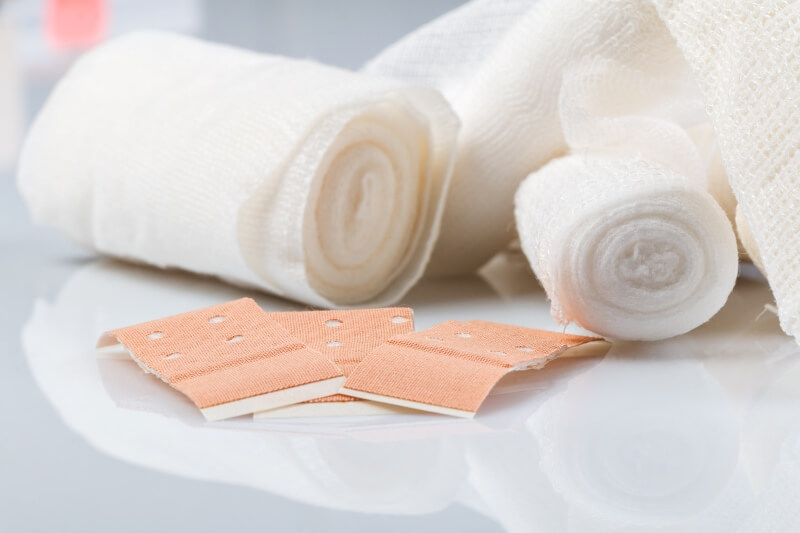
Compresses are made from highly absorbent materials such as gauze, nonwoven fabric, or cellulose. They are used in various shapes and sizes as wound dressings for bleeding, exudating wounds, or burns, or cut to size as swabs. When you choose to order bandages from Medicalcorner24, you can select from both sterile and non-sterile packaged bandaging supplies. Many of these wound care products can be sterilized in an autoclave and are therefore reusable. Compresses are also available in special forms, such as with a Y-slit for optimal coverage of the entry and exit points of drains, tracheotomies, or extensions. Professional compression bandages, nonwoven compresses, or slit compresses are frequently used as surgical bandaging materials.
Mesh bandages and tubular bandages are each designed for the fixation of compresses or wound dressings. They are primarily used on limbs or for head bandages that are difficult to secure with other bandaging materials. For example, a tubular bandage can be pulled over an injured leg like a stocking and maintains freedom of movement due to its stretchability. Mesh bandages, on the other hand, can be easily pulled over the head like a cap to keep bandages in place. Order now mesh-like bandaging materials that are very skin-friendly, making them suitable for use on sensitive skin.
We offer a comprehensive range of bandages. In our online store, you will find adhesive bandages, roll bandages, and plaster strips in various sizes and cuts. Waterproof bandages, cushioning blister bandages, or specialized finger bandages allow for the treatment of smaller abrasions and injuries on all parts of the body. Adhesive plasters are among the most versatile types of dressings and are used as first aid material, household and practice wound care, or in special forms as surgical dressing materials or bandages for post-surgery. Order high-quality medical wound healing plasters at affordable prices for your needs.
Padding bandages made of cotton or viscose are used as protective material when applying dressings. These absorbent and soft bandages prevent painful pressure points and optimally absorb wound fluid, making them important dressing materials and hygiene products for wound care. As cushioning wound care material, they protect treated wounds from mechanical pressure. They can also be used as decubitus dressing material. Padding bandages are available on rolls like medical gauze rolls, ready for cutting, and padding wadding is also available in zigzag layers for easy tearing in the desired amount.
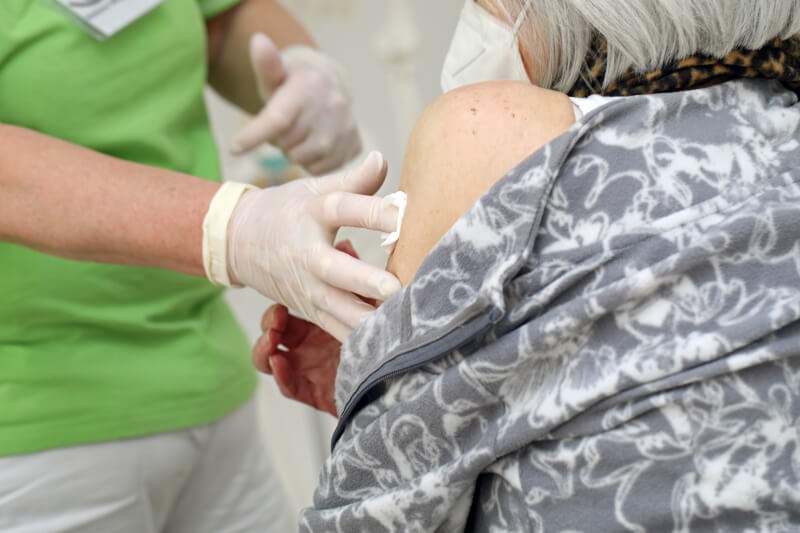
Dressing materials like swabs are used for wiping off blood, dirt, and other substances or for applying disinfectants or ointments. The versatile swabs, made from non-fibrous cellulose wadding, are suitable in sterile form for direct contact with wounds and are considered classic surgical bandages and dressing materials.
Tamponades are made from pure cotton. When sterilized, they are used for filling deep, complicated wounds or bleeding body openings. They can, for example, help stop severe nosebleeds. Special ointment tamponades are also impregnated with active ingredients that are intended to support the healing process. Tamponades are important medical dressing materials for treating wounds that would otherwise be difficult to dress.
Order First Aid Materials Online for Your First Aid Kit
At all times, your first aid kit should be within easy reach. Dressing materials can serve as primary first aid materials to ensure immediate care for injuries and can save lives in case of emergency. Rapid first aid measures can, for example, effectively minimize scar formation.
Of course, having the right equipment, especially the proper dressing materials, is essential for providing effective help. The exact contents may vary depending on the location, but there are certain dressings that should always be available. The following dressing materials are an essential part of the basic equipment to avoid wound contamination and promote wound healing:
- Wound care supplies such as bandages and dressings
- Compression bandages
- Dressing packs
- Fixation bandages
- Bandage scissors
It is important to regularly check the contents for completeness and durability and replace any missing items if necessary. In addition to professional bandaging materials in various versions, you can also order complete refill kits with first aid materials and dressing material sets at Medicalcorner24.
Additional Wound Care Products Available at Affordable Prices from Medicalcorner24
The selection of affordable dressing materials is complemented by various wound treatment items and hygiene products for wound care or bandages for sports injuries. We offer wound compresses, wound bandages, dressings, as well as wound disinfectants, ideal for hygienically cleaning soiled wounds. Additionally, we provide a wide range of products in diagnostics, hygiene, care supplies, and practice essentials for a comprehensive medical kit.
Order hygienic dressing materials today and treat wounds and other injuries effectively with products from the Medicalcorner24 shop!
FAQ on Professional Dressing Materials
Here are some frequently asked questions about professional dressing materials used in hospitals, clinics, at home, or in care settings. If you have any additional questions about bandages, dressings, or other medical supplies, please feel free to reach out to our customer service team.
What is dressing material? The term "dressing material" encompasses all medical bandaging supplies used for initial care or continued coverage and treatment of injuries and wounds. Dressing material is used, for example, to stop bleeding, protect wounds, prevent infections, and support wound healing. Some dressing materials are also used to secure and fix bandages or medical devices like cannulas or tubes to the patient or to a treatment bed.
What is considered dressing material? Dressing material includes, among other things:
- Wound Dressings (e.g., sterile compresses, gauze bandages, plasters and different band-aid types)
- Fixation Materials (e.g., fixation bandages, dressing sheets, adhesive plasters, elastic bandages)
- Hemostatic Materials (e.g., pressure bandages, absorbent compresses and wound dressings, silicone wound dressings, hemostatic cotton wool or tampons)
- Protective and Supportive Materials (e.g., wound covers, plaster bandages, or cast bandages)
- Special Aids (e.g., triangular bandages, eye compresses, finger bandages, or net-like dressing materials)
Many of these materials can be found in first aid kits, emergency backpacks, or medicine cabinets and are essential for the initial treatment of injuries. Other products are part of surgical dressing materials and bandages for post-surgery used in hospitals and doctor's offices.
Expired bandages should generally not be used for first aid or medical care. This is because the sterility and material properties may deteriorate over time.
What happens when bandages expire?
- Sterility decreases: Sterile dressings and bandages can lose their protective effect as the packaging may become porous over time. This could allow germs or dirt to enter, increasing the risk of infections.
- Reduced adhesion & elasticity: Bandages and adhesive tapes or adhesive plasters may no longer stick properly after a long period, and elastic bandages might lose their stretchability.
- Decreased absorbency: Wound dressings may lose their absorbency or become brittle.
Expired medical bandages, however, can still be used for non-sterile purposes. For example, they can be used for training in first aid courses, for cleaning and wiping surfaces, or as padding material in DIY and crafting projects. For first aid and professional medical applications, always use fresh, valid bandages.
The shelf life of bandage materials varies depending on the type of product and the manufacturer. Typically, the expiration date is between 5 and 20 years from the date of manufacture. The exact expiration date of bandaging supplies is usually indicated on the packaging or the product itself.
Here are some general guidelines for the shelf life of different types of bandage materials:
- Sterile bandages: Compresses, bandage packs, or sterile swabs typically last between 5–10 years.
- Non-sterile materials: Unsterile materials such as gauze bandages, triangular bandages, or fixation bandages often last longer or may not have an expiration date.
- Plasters and adhesive tapes: These are usually only usable for about 5 years, as the adhesive can dry out, causing them to lose their sticking ability.
The actual shelf life also depends on proper storage and handling of the bandages. When stored in a cool, dry, and light-protected area, bandaging materials can last longer. Always check the condition of the packaging—unopened original packaging ensures the indicated shelf life.
Medical bandaging materials have an expiration date to ensure the safety and effectiveness of the materials. This date guarantees that the material retains its protective, sterile, and functional properties throughout its storage period.
Here are some reasons for the expiration date:
- Loss of sterility: Sterile wound dressings, bandages, and compresses are sealed in airtight packaging, but over time, the packaging may become porous. This can allow germs to penetrate and contaminate the material.
- Material aging: Elastic bandages, plasters, or adhesive tapes may dry out, become brittle, or lose their adhesive strength. Gauze bandages or wound pads could lose their tear resistance or discolor.
- Absorbency and protective function: Wound dressings, compresses, or cotton wool may lose their ability to properly absorb blood and fluids over time.
- Medical regulations and standards: In Germany and the EU, first aid materials are subject to legal requirements (e.g., DIN 13164 for car first aid kits). These regulations mandate that expired materials must be replaced to ensure safety, and this includes bandage materials.
After the expiration date, medical bandages and first aid materials should no longer be used. However, they can still be used for practice or non-critical applications.
Depending on the type of injury, specialized bandage materials are used:
- Small cuts & abrasions: Adhesive bandages or quick bandages
- Larger, heavily bleeding wounds: Sterile compresses and pressure bandages for antiseptic wound care
- Deep wounds or lacerations: Wound closure strips and fixation bandages
- Burns: Burn wound dressings and aluminum foil compresses
- Eye injuries: Eye compresses and triangular bandages
- Sprains and bruises: Elastic bandages & cold compresses
Bandages are made from different materials, each providing stability, compression, or protection depending on their intended use. The main materials include:
Elastic Materials (for Flexibility & Compression):
- Elastane (Spandex, Lycra): Provides stretchability and a good fit to the body.
- Latex or Rubber: Used in elastic bandages, though it can trigger allergies. An alternative is often a mix of cotton and elastomer.
- Neoprene: A warming, elastic material frequently used for sports and support bandages.
Breathable Materials (for Comfort & Skin-Friendliness):
- Cotton: Skin-friendly, soft, and breathable, often combined with synthetic fibers to enhance its properties.
- Polyester & Nylon: Lightweight, durable, and quick-drying, often included in modern bandages.
- Microfiber Fabrics: Particularly breathable and moisture-regulating for a comfortable wearing experience.
Stabilizing Materials (for Support & Protection):
- Silicone Pads & Gel Inserts: Cushion impacts and relieve joints. Hydro-gels are also used in specific burn dressings to promote healing.
- Metal Splints & Plastic Reinforcements: Provide additional stability in severe injuries or orthopedic bandages. They can help immobilize the injured limbs completely.
- Foam Inserts (e.g., EVA foam): Offer extra protection against mechanical forces and increased comfort.
Self-Adhering & Fixing Materials (for Secure Fit without Adhesive):
- Cohesive Materials (Latex-Free Polymers): These materials stick only to themselves, not to skin or hair, making them ideal for flexible bandages and self-adherent wraps. They are often made from a blend of cotton, viscose, and polyamide.
- Velcro Straps or Elastic Bands: Make it easier to apply and adjust the bandage.
The choice of the right material depends on the individual need—whether for stabilization, pain relief, or supporting the healing process.
1. Protective Dressings (Wound Dressings)
- Purpose: Protects the wound from infections, dirt, and moisture to allow it to heal undisturbed.
- Typical Materials: Sterile compresses, wound pads, band-aids, hydrocolloid dressings (for burns or exudating wounds).
- Application: For open wounds, cuts, abrasions, or after surgeries. They are often changed and renewed as needed.
2. Pressure Dressings
- Purpose: Stops bleeding by applying pressure to the injured area.
- Typical Materials: Sterile compresses, elastic bandages, gauze bandages.
- Application: For heavily bleeding wounds or to stop bleeding from injuries.
3. Support and Relief Dressings
- Purpose: Stabilizes and immobilizes joints or muscles.
- Typical Materials: Elastic bandages, tape bandages, plaster casts, cast bandages, zinc oxide bandages, orthoses.
- Application: For sprains, bruises, strains, or fractures.
4. Fixation Dressings
- Purpose: Fixes wound pads or medical devices in place.
- Typical Materials: Cohesive bandages, diverse band-aid types, tubular bandages, mesh bandages.
- Application: To secure compresses or splints without applying excessive pressure.
Each of the four main types of dressings has a specific function and should be selected based on the type of injury or medical need.
Depending on the intended use, bandages can be combined with special ointments, pads, or medical materials to support healing, relieve pain, or provide additional protection.
Ointments & Active Ingredients for Healing Support
- Pain-relieving & anti-inflammatory ointments: (e.g., with Diclofenac, Ibuprofen, or Arnica) Used for treating bruises, sprains, or joint pain.
- Cooling gels & ointments: (e.g., with Menthol, Camphor, or Heparin) Promote circulation and reduce swelling in sprains or muscle irritations.
- Wound-healing ointments: (e.g., with Dexpanthenol or Zinc) Support the regeneration of skin in superficial wounds or abrasions.
Pads & Cushions for Pressure Relief
- Silicone or gel cushions: For shock absorption and pressure distribution, e.g., for joint problems or tendon inflammation.
- Foam inserts (EVA foam): For additional stabilization and custom fit of the bandage.
- Air or fluid cushions: Primarily used in medical orthoses for dynamic pressure redistribution.
Sterile Wound Pads & Protective Materials
- Sterile compresses or gauze pads: When the bandage is worn over a wound.
- Hydrocolloid or gel pads: To keep the wound moist and promote better healing in abrasions, pressure ulcers, exudating, or burn wounds.
- Antimicrobial pads (e.g., with silver or activated charcoal): To prevent infections in open wounds.
The choice of the right dressing material depends on the type of wound. Here is an overview of the best materials for different wound types:
For Acute, Fresh Wounds (e.g., cuts, abrasions, or lacerations)
- Sterile Compresses & Gauze Bandages: Protect the wound from dirt and infections.
- Self-adhesive Wound Plasters: Ideal for small injuries, to protect and secure dressings.
- Hydrocolloid Dressings: Promote healing by providing a moist wound environment and reducing scar formation. Often bandages for burns.
For Heavily Bleeding Wounds
- Pressure Dressings (e.g., with sterile compress and elastic bandage): Stop bleeding by applying targeted pressure to the affected area.
- Superabsorbent Dressings: Absorb large amounts of wound fluid and prevent wound maceration.
For Infected or Chronic Wounds (e.g., pressure ulcers, venous ulcers)
- Silver-containing Wound Dressings: Have antibacterial properties and help fight infections as necessary in antiseptic wound care.
- Alginate Dressings (e.g., made from seaweed): Promote wound healing, especially in heavily exuding wounds.
- Activated Charcoal Dressings: Reduce odors and bind bacteria.
For Burn Wounds & Sensitive Skin
- Hydrogel Dressings: Provide moisture and cool the wound, ideal as bandages for burns.
- Foam Dressings: Protect sensitive wounds from friction and pressure.
Each wound material has specific properties – choosing the right one can accelerate healing, prevent infections, and improve patient comfort.
The choice between sterile and non-sterile bandages depends on the type of injury and the intended use of the dressing materials:
When Should a Sterile Bandage Be Used?
- For Open Wounds: To protect against infections (e.g., cuts, abrasions, or surgical wounds).
- For Heavily Bleeding Wounds: In combination with sterile compresses for blood control.
- After Surgical Procedures: To keep the wound germ-free.
- For Immunocompromised Patients: Especially important to prevent infections from bacteria and germs.
Examples of Sterile Dressings: Sterile compresses, wound dressings with antibacterial coatings, as well as hydrogel and hydrocolloid dressings.
When Is a Non-Sterile Bandage Sufficient?
- For Securing Wound Dressings: When the wound is already protected by a sterile compress.
- For Closed Injuries: For example, in sprains, contusions, or swelling.
- For Support and Stabilization: Such as for joint issues or sports injuries.
Examples of Non-Sterile Dressings: Elastic bandages for stabilization, net and tubular bandages for fixation, or self-adhesive wraps for sports injuries.
Conclusion: Sterile bandages are essential for open wounds, while non-sterile bandages are sufficient for fixation and support. However, it is always important to ensure that wounds are kept germ-free to avoid infections!
We are happy to advise our customers from the UK without obligation on the subject of Bandaging Material
Please send us an email to ticket@medicalcorner24.com.


